#including the bus I was on to Dublin breaking down!
Explore tagged Tumblr posts
Text
Saw these guys live at the Olympia in Dublin tonight (well, last night now, I guess) and they went a long way to making up for what was a pretty dismal week otherwise. I think this was the first song of theirs I ever heard, so I thought I’d post it.
youtube
#when I say it was a bad week I don’t mean anything truly horrible happened#it was just a lot of tiresome little things all piling up at once#including the bus I was on to Dublin breaking down!#but I got there just in time to see these guys walk on stage so at least I didn’t miss any of their set#amble#Youtube
6 notes
·
View notes
Text
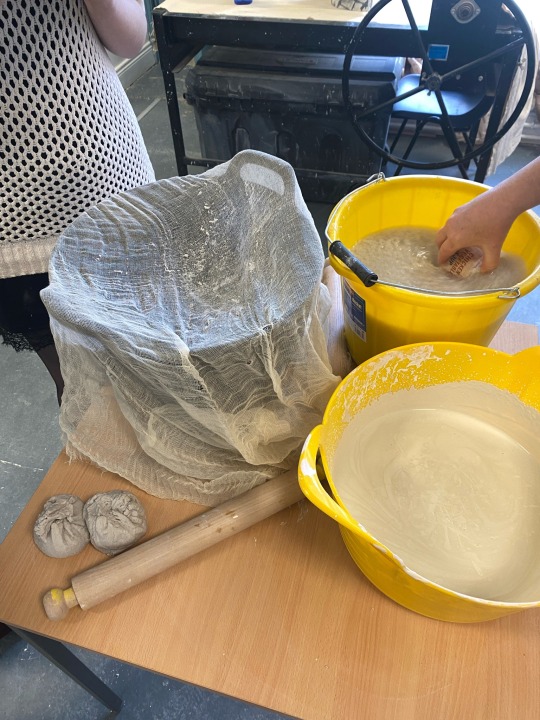

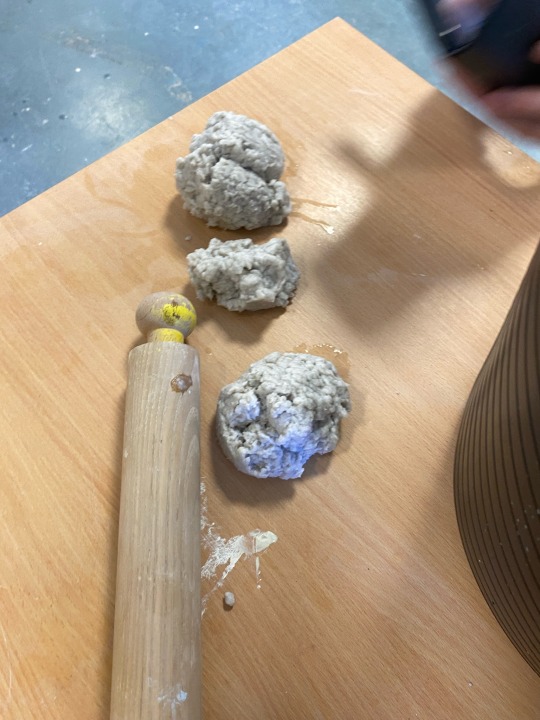
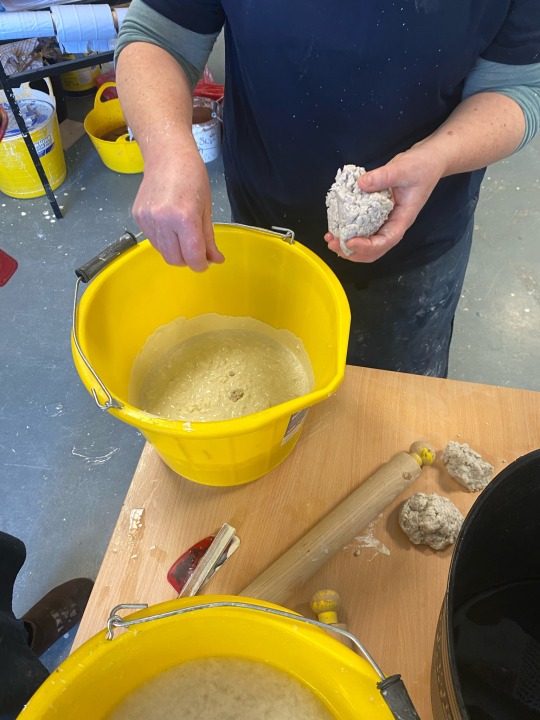
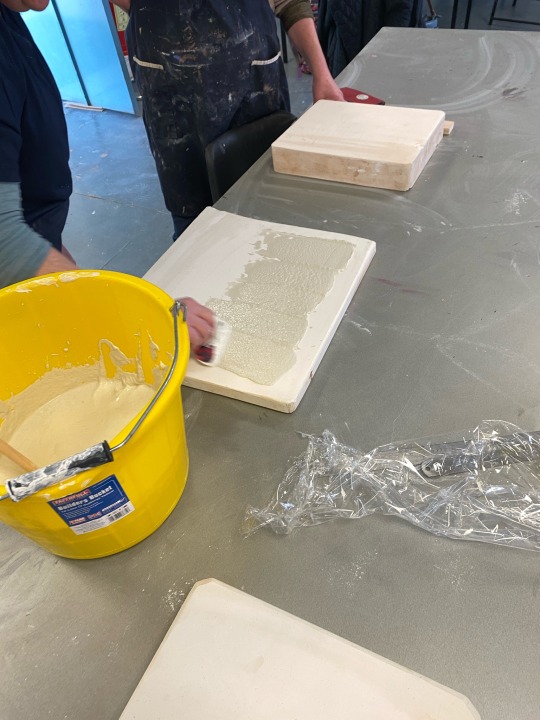

Paper Clay!!!
Today we learned how to make paper clay! So cool, so fun.
Step one: Slowly add some cheap toilet paper (piece by piece into warm water) breaking it up as you add it.
Step Two: Break up pieces of porcelain into small pieces.
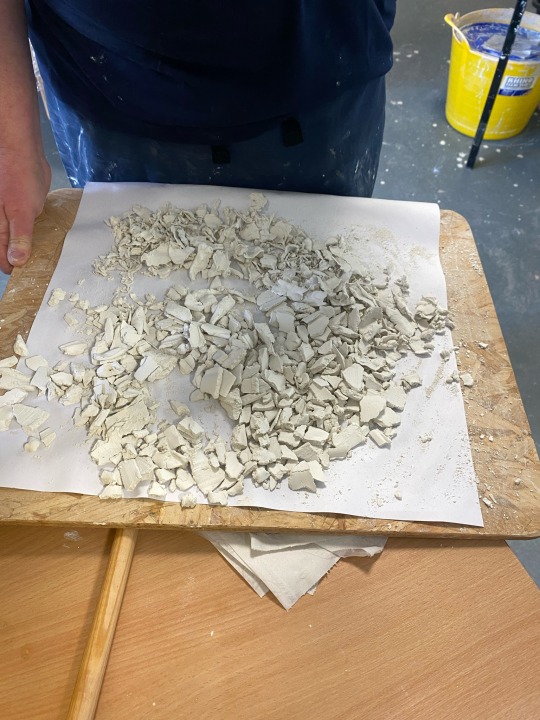

Step three: Blend the porcelain and water until its a smooth consistency
Step four: With a cheese cloth drain the water out of the toilet paper but not all of the water
Step Five: add the mixture together with the porcelain and blend everything well together
Step six: Get yourself some fired slabs and scrap them back with a metal ruler to make sure they're smooth. Add you mixture on in thin layer and smooth over with a rubber kidney. You can do about three-four layers.
Step seven: When its dry peel a corner off and lift it up and voila!
I was thinking of making a porcelain train out of train tickets made out of paper clay. The porcelain allows light to pass so it would be cool to have it hollow and put fairy lights underneath so give the train a warm glow. I think I would do it in the shape as the new train because its so lovely and warm as opposed to the old train which has rubbish doors and is very cold and miserable.
On the train home I noticed that nobody was talking to each other but sometimes your feet have an awkward conversation/ fight for space. My friend was on the new train from Dublin to Galway and he was telling me about a funny interaction. Its my friends 20 year old GAA brother. He said he was sitting across from a "small boy wearing an anime t-shirt" and he unapologetically kicked Rorys feet out of the way to give himself more space. Rory described it as "getting alpha maled by some feet". Neither of them spoke a word to each other but yet they had a whole interaction. It was a foot conversation? I thought it was interesting and funny and something that often happens on the train so I made a silly little drawing about it.

I made the little drawing yesterday and I thought I would include it even though I hate it because you never know sometimes the bad drawings or the ones you hate can have a small part of it that can lead to an idea you love later down the line. It was just about me being annoyed by someone skipping me in the queue for the bus and then hearing them say to the driver that they didn't have a ticket to the fully booked bus. So annoying. I just have a favorite seat I like to sit in (its the one beside the emergency exit at the back of the bus because no one can sit behind you so you can always out your seat back). I did think it was funny to call City link Sitty link because it the same word but with a different meaning. Maybe I'll do something with that but I'm not quite sure yet. I don't really like taking sound recordings on the bus because its very quiet and boring. Maybe its too comfortable and everyone is too realaxed to be interesting.
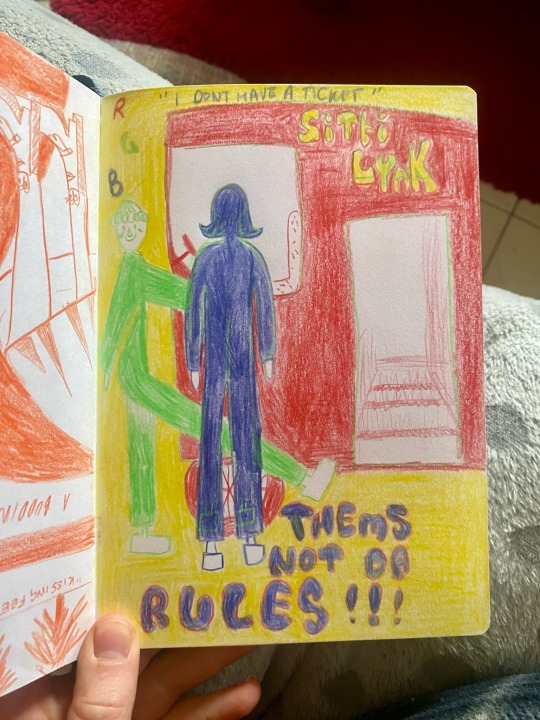
0 notes
Text
Let’s Talk About Trackers...
Because of the major talk about them yesterday and how an anon tried to throw me under the bus, I want to make an informative post about the specific tracker I use and certain others do too (assuming they still use these). This will also go under a keep reading so you don’t have to scroll in case you read it and then don’t wanna scroll past it a second time.
I personally use a site called statcounter. What is stat counter? Well, let me explain with an excerpt from Wikipedia!
“StatCounter is a web traffic analysis website started in 1999. Access to basic services is free and advanced services can cost between US$5 and US$119 a month. StatCounter is based in Dublin, Ireland. The statistics from StatCounter are used to compute web usage share for example. As of May 2019, StatCounter is used on 0.9% of all websites. StatCounter statistics are directly derived from hits—as opposed to unique visitors—from 3 million sites, which use StatCounter, resulting in total hits of more than 15 billion per month. No artificial weightings are used to correct for sampling bias, thus the numbers in the statistics can not be considered to be representative samples.”
Statcounter I find has some cool features too if you do run a business site, which I aim to do in the future, here’s some of the cool analytics stuff they have if you’re a business marketer:
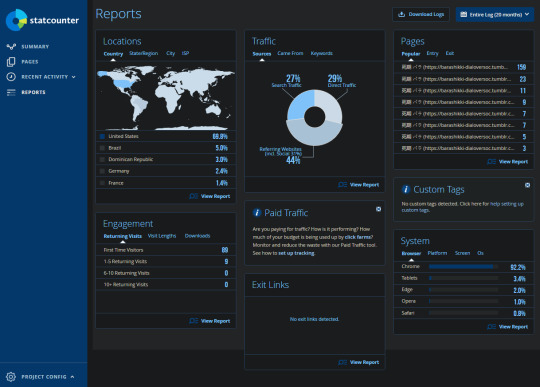
This above is a capture taken for the tracker on my OC blog @ / barashikki-dialoversoc
This tool here provides where the majority of your people come from, so it will help businesses to have features such as this, so StatCounter is cool to use for business and marketing.
But that’s not why we’re here, are we?
StatCounter says they provide you with IPs in hopes of blocking/banning them from your site and/or stopping fraud on your website.
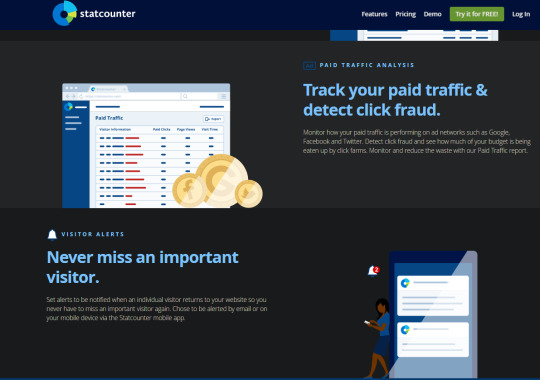
Sure, that’s useful as I personally use that to block people’s IPs if they send me hate anons. But here is how it’s an issue... This specific tab, which I know M/C uses quite often from my former friendship with her: Visitor Activity
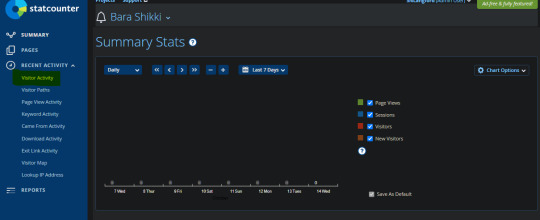
Now, let’s go there and break it down. I will be censoring sensitive information like people’s locations and IP addresses to protect them.

I want to also address the “xxx is now using 100% of its log space” too.
It may be hard to read, but it says the following
“Your Project Bara Shikki is now using 100% of its log space. This means that your website traffic data for detailed stats older than 7 months* will be overwritten to make room for new data. You can upgrade for $9/month to increase your log to 10+ years*. If you don't mind losing this old data for detailed stats, then no action is required on your part. Summary Stats are included with all plans and are unlimited.
* Estimated based on your current traffic”
For my other blog @ / dialoving-lemons, it deletes this info in 7 days due to the high demand traffic (it is a LOT more popular than any of my other blogs despite me being on hiatus there).
So while that is good, this information stays for a while. If someone is paying for this service, they can keep this info for a long time.
Now onto the part we are mainly addressing, addresses and IPs. I will use my own visits for the example (the white censor). And yes, you can appear on your own tracker as it picks anyone up who visits the URL.

I color coded this so we can do a breakdown.
Yellow is my city. Green is the state (will be providence if you are in another country). Then you see “United States” as the country it says I’m from. Your country’s flag also appears before your location.
^^^This here is already pretty accurate and sensitive information, and we haven’t even gotten to the second line yet.
For the second line, we have these: Purple is your internet provider. White, that’s your IP. See that tag next to it? You can click on that and make notes in it for when that person returns to your url. You can even sign up for notifications to get emails or alerts on your phone (if you have the statcounter app). How do I know this? This is how:
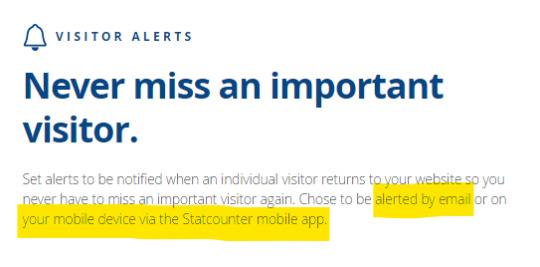
Incognito doesn’t have dark mode, so sorry for bright image lol
Idk about you guys, but that’d make me uncomfortable to know someone could just get a ping saying I’m visiting their page. Again, I don’t know what features M/C uses, so I can’t say if she has this or not.
So not only can you find someone’s location, internet provider, and IP (which I think is enough for someone who hack or screw you over somehow, idk. I’d want to look that info up) but you can also stalk when they’re on your blog. This is a big YIKES.
Now back to the breakdown of the image from earlier...

You can learn what device they used, their browser, get a timestamp, and also how long they were on your page. I personally don’t care sharing this info, many of us use the most updated browser of our choice and most of us are on windows 10 for computer users.
So... yeah. While I use statcounter myself to block haters and redirect their IPs so they can’t get on my page anymore, I feel this site does give out too much information. On top of that, the one we all know who uses this software also has some software that checks who unfollows her. She uses these to get dirt on people and to expose them, it is not for her safety.
Now some tips on how to be safe if you don’t want to be tracked thanks to me testing things out:
Use the tumblr app.
The tumblr app uses coding for mobile usage. It does not rely on urls, but another form of code. StatCounter cannot log this code, so you will not appear on the visitor activity tab.
View blogs in side view

This is side view for those that don’t know. Side view acts a lot like the app in terms of the coding. So viewing like this is safe for you to not appear on trackers.
StatCounter relies on you typing in and clicking on urls on someone’s tumblr page (if installed on a tumblr).
As long as you are on a way that doesn’t rely on url systems, you are safe from appearing in someone’s tracker.
And a final note, if you are going to use one like I do, for blocking haters’ IPs, then I highly recommend putting a disclaimer in your description. I immediately did that when I installed mine so people knew they’d get rerouted if they started crap with me. I personally feel that keeping it secret that you have a tracker is violating someone’s consent as you are gathering info without their permission. By saying you have one, them being able to use ways where they won’t be tracked is very useful and helps them feel at ease knowing they can decide if they’re fine popping up on your tracker or not. Here is an example disclaimer you can put if you do put one in. Feel free to copy and paste too!
"Disclaimer: I use a tracker that allows me to see visitors’ IPs so I can block them if they cause problems for me, proceed at your own risk"
67 notes
·
View notes
Text
chapter one; wayward son
Enna Scanlan bounced in her computer chair. Only two hours to go before Owen’s return to their village in around six years. Her best friend, Grace, stared at her over her mug, an amused smile across her face and dark green eyes creased. Enna’s eyes had been flicking over to the clock on the other side of the room since she got in at nine this morning. Her personal phone was barely out of her sight and checked every five minutes. It was usually kept tucked away in her bag in case their boss caught sight of it. ‘No personal phones in the office’ until lunch time was a strict rule. Then, Enna had devoted the entirety of today’s lunch hour to chasing signal around the huge office and cursing their hotel’s terrible location.
“He’s not texted then?” Grace asked mildly, sipping her tea, and twirling a red curl. That glare was thrown at her again. She chuckled, “I don’t get it- you’re in contact everyday, why is today any different?”
Enna and Owen couldn’t go a single day without contacting each other. There was always some text or phone call to interrupt her day. Enna had once gone away with her boyfriend on a surprise trip and had neglected to tell Owen. Two days had passed without contact and Owen had gotten so worried he’d rung Enna’s mum. There had been a long talk about boundaries after that, but their daily contact had resumed.
“Today is the day I finally see him,” Enna said, looking so excited Grace might have been a little jealous had she not already understood that she always came second to Owen. If only Sean, Enna’s boyfriend, would remember that too. Nothing could break Enna and Owen’s bond from birth, including not seeing each other for a year or two.
Enna sighed and grabbed her mug. Just as she began to stand to go to the kettle, she saw that Grace had already poured them their 3pm brews. She raised her mug, a kitsch red and blue offering, in an apologetic salute.
Enna knew she could become a little occupied in her friendship with Owen, but she’d never been this bad before. They’d been best friends growing up and in university but had still managed lives outside of each other. The ever-lengthening time apart and Owen’s sudden urge to come home had made Enna realise just how long it had been. They’d always planned visits but with life happening all around them it had never quite panned out as often as it should.
“Sorry,” Enna grimaced when she realised that she’d gotten lost in her head again. Grace just laughed, used to the memory lane disappearances by now.
“No worries. Just remember you’ve got ‘the future Mrs O’Donaghue’ breathing down your neck.”
“Oh f-” Enna squealed. Dragon Bride, a young woman who only answered to ‘the future Mrs O’Donaghue’, was getting married in a week’s time and her wish list only kept growing. As events coordinator for the hotel Enna had dealt with many difficult clients over the years. Dragon Bride beat them all. Enna shuddered to think of the consequences of ignoring her.
Two hours later, Enna pretended to bash her forehead against her desk as a high-pitched voice screeched into her ear, “this of the utmostimportant! Do you understand?”
Enna breathed in deeply through her nose and bunched her hair into a fist, “ma’am. Your wedding is in two weeks, it might be difficult to find a petting zoo to rent out in that time.” Her exhale whistled through gritted teeth.
“I don’t want it for the wedding! I want it for the hen do. Is this making sense to you now?” Dragon Bride yelled again. Enna’s knuckles whitened in her hair.
“That is in a week so it’s the same-”
“Just get it done.” Dialling tone rung loud in her ear.
She raised her head from her desk and stared at the phone. She let out a loud, frustrated squawk and slammed the phone down, “This woman is a nightmare!”
“Who’s a nightmare?” A cheerful voice cut through Enna’s frustration. She jumped with a yelp. Swivelling around in her seat she saw her boss, Conor, beaming widely at her. A charismatic man, half the office was in love with him. Blonde hair flopped over his twinkling eyes, always looking suitably messy from his paddle-boarding habit. He looked so much like a stereotypical Australian surfer that it was sometimes a little difficult taking him seriously as her boss.
“The future Mrs O’Donaghue.” Grace supplied, voice light with barely contained amusement.
“Ah,” Conor nodded, “the Dragon?” Enna blinked at his flippant tone. He was a very relaxed boss, insisted everyone called him and his wife by their first names, invited all of his staff down to the pub every Friday and knew them all by name, right down to the ground staff he saw maybe once a year, but usually he was quite respectful towards clients. Enna nodded dumbly.
“What did she want this time?” There was an annoyance in his voice that Enna couldn’t quite parse. Conor never got involved in her clients until Enna came to him with a problem. Then he’d hear the problem from both sides and try to help her solve the issue. She’d only mentioned Dragon Bride once in passing and Conor had dismissed her worries, promising to take her side in whatever.
“A petting zoo!” Grace replied with malicious glee. Enna shot her a look over her shoulder and got a quiet ‘what’ shrug back.
“Who’s paying for the wedding?” Conor asked without preamble, “trust fund baby?” It clicked in Enna’s head. Despite his own wealth from being a hotelier Conor was a snob about rich people. He hated people who had been born into wealth rather than working for it. He thought it made them spoilt and irresponsible. In the case of Dragon Bride, he was right.
“Her father,” Enna muttered. She didn’t want to add fuel to a possible tirade about the plight of the common people. Grace was giggling behind her, turning it into a cough when Conor furrowed his brows at her.
“Ignore her! If she complains I won’t take any notice. Just do your best! And put your phone away,” He nodded towards to Enna’s beeping phone, “oh wait, look it’s five. Pack up lads and ladies! It’s home time! Who’s coming to the pub?” He grinned and swung his arms around to suggest everyone wrap up what they were doing. Everyone instantly stood, having waited for their boss’ weekly pub invitation. Enna picked up her phone with a wry grin towards her eccentric boss, huddling people out of the door. A text from Owen awaited her – he had arrived.
She bolted for the door.
She arrived at the small, red brick bus station twenty minutes late and swearing the entire time. The bendy country roads, thankfully leaf free this time of year, were difficult to navigate anyway. Having vengeful farmers move their herds during rush hour just made it an exercise in anger management. She parked the car across the road, kicked the door shut with another loud curse and looked up to laughter.
Across the road, crouched against the bus station’s toilets walls, was Owen and he was laughing at her. He ran a hand through his hair. Enna grinned back at him, anger instantly melting away. She surreptitiously studied him as she tried to get to him. It had only been around two years since she’d gone to see him in the UK, but he looked untouched by that time. His hair still swung messily around his ears and his eyes still creased when he smiled.
“Sorry!” She yelled over the traffic, “I meant to text but signal on this road y’know,” she carried on as she ran across a gap in the cars going home from the city. Owen waved a dismissive hand as he stood and held his arms out. She threw herself into them apologising profusely, “Alan-”
“-is still punishing us mere mortals for not choosing God’s own profession by letting his sheep loose during rush hour?”
“Exactly!” She beamed as she drew away. Her eyes darted down to what he had been crouched over, “is that all you have?” Disappointment washed over her as she eyed the small duffle bag.
Owen laughed loudly. He ruffled her hair before dropping an arm around her shoulder. Picking up his bag, he guided her towards the luggage hold office opposite the ticket booth. Two huge suitcases stood in wait, “fear not little one, I’m here a while.” Enna let out a breath she didn’t realise she’d been holding. It was time to bring Owen home.
Later that night, and one sheep free journey later, the two stood outside their old home away from home. Ramble Inn was an old pub in a beautiful Georgian building with red trims around the window. The door had also been red at one point, but the paint had now peeled and faded to a faint pink. As they were growing up it had been their second living room. It was where they came after Mass, where they came after a match, and where they came after school once you hit fifteen. Try as you might though, Tom would never serve you.
Owen laughed at memories of a bygone era. Him, Enna, Grace and Liam, Enna’s older brother, clustered around a table playing dominoes with the old men. They’d enjoyed playing at being adults and the real adults had enjoyed indulging them. He wondered if they were still there.
“Tom still won’t serve you underage.” Enna guessed at his previous thoughts. Owen rubbed at his beard. One night, drunk and seventeen, Owen had tried to get served. He’d gotten quite rowdy; Tom had thrown him out and he’d landed on his face. He’d never forgotten the pain of a dislocated jaw.
“Tom’s still psychic, knows everyone ages, even the passers through. Kids don’t get anything but juice,” Enna grinned at him lost in his misty-eyed memories.
“You two going to stand outside here all night?” A voice cut through their reverie. They turned their head in unison. Caoimhe Walsh stood there with a hand on her hip and bright eyes fixed on Owen. A more recent addition to the village, a blow-in from Dublin, Caoimhe had been an instant hit. Tall, blonde, and beautiful, she was everything Enna wasn’t but every bit as sweet as she looked.
“Keev!” Enna grinned, “thought you were out with the girls tonight?” Unlike Enna, who found socialising wearing, Caoimhe thrived on it, flitting happily between social groups, welcomed by most.
“Yeah, we decided on a quiet one instead.” She slung an arm around Enna’s shoulder and threw a hand up to the Ramble Inn’s curling gold letters. Enna snorted. Caoimhe shot a wolfish grin back. They both knew she’d have no such thing.
Caoimhe’s eyes finally strayed to where Owen was looking at them with a slightly dumb smile on his face. Noticing Caoimhe looking at him, Owen offered a slightly dumb wave.
“Owen?” Caoimhe’s eyes went wide and, after a beat, threw her arms around him in a massive hug, “oh my god, you’re that Owen?”
Enna blinked rapidly at them. Keev had moved the village long after Owen had left. Although she had featured heavily in the stories Enna told him, he never mentioned knowing her.
“You’re that Caoimhe?” His laugh was jubilant as he picked her up, “I never made the link! Enna talks about you all the time. Oh, Eni, do you remember that business trip I took like two months ago?” Owen turned back to her when he caught sight of her tilted head and querying expression.
Caoimhe came back to Enna’s side and slid her hand into the hook of Enna’s arm. She grinned at her expectantly, “and remember that holiday I took two months ago?” She prompted when Enna didn’t connect the dots straight away. It must have all been too exciting because she didn’t wait for a response, “well we met at this bar, got chatting and when I said I was living in Ballygra… how did we not make the connection?”
Enna pulled a face. It certainly seemed a little unbelievable. There were so few people in the village and none with her name. Before she could query it, Keev said,
“Can’t believe Ballygra produces such hot men.” She winked at him. He nodded and winked back with a flirtatious grin. Enna snorted.
Nothing had changed then. It had been like this since he was about twenty-one. That’s when the braces had finally come off, bed head stopped being his only hair style and he’d discovered the power of personal hygiene. Since then people had flocked around him. She saw it, of course, but actual attraction was hard to summon when you’d seen them hungover countless times since you were fourteen.
“Are you coming to Midnight’s, Owen?” Caoimhe beamed as the thought occurred to her.
Saturday lunch at Café Midnight was their tradition; Enna, Liam, Grace and Caoimhe. Sometimes Sean would pop in his head, but Friday night was Boys Night and lunches were usually slept through as a healing process. Caoimhe dragged the pair inside instead of waiting for an answer. She already knew that, when together, where Enna was Owen would also be.
The Ramble Inn was the same as Owen remembered it. The wooden bar stood proud in the middle; battered, worn, and smelling of spilled beer and disinfectant. Old, wobbly stools stood guard including the one Enna had completely unpicked when she was fifteen. Tom had made her re-sew another one and, despite it being the ugliest thing in the world, he had made her sit on it every time she came in for years.
It was filled with the usual Friday night suspects. On the right-hand side, the men still played their dominoes. Old Man Charlie still had his whiskey clutched in his hand and an unlit cigarette hanging from his lips, smoking ban be damned.
On the left-hand side sat the younger crowd, some with kids because who wanted to cook on a Friday night? Teenagers tucked in the corner with juice, a group playing darts. Tom stood through it all, keeping court with a raggedy dishcloth tossed over his shoulder. The only difference was Tom’s hair now silver all over and there were extra wrinkles around his eyes. A spotty teenager served as a glass collector.
Caoimhe left Owen’s side the moment they entered. A group of women sitting at the back waved her over. One of them nodded to Owen and Caoimhe flew over to them to spread the gossip of his return.
Owen turned for Enna, but she had already brushed past. She nodded to all the familiar faces as she moved towards the bar. She leant on it, sitting on her stool, and laughed at whatever Tom said to her. Then she turned to point at Owen still standing by the door. Tom’s bushy eyebrows shot up.
“You’ve grown boy!” Tom yelled over the pub noise. It fell quiet. Everyone looked over at him. He shifted on his feet and offered an awkward wave. It took a few seconds, but the pub noise swelled once they recognised Ballygra’s wayward son. Old Man Charlie and his group raised their glasses. Tom beckoned him over. He shuffled over and Tom busied himself by the bar,
“You still Jameson’s?” He grinned his familiar, crooked smile and pushed a glass towards him. His returning smile was awkward, wondering how his jaw might last this encounter. A beer was in Enna’s hand and he raised an eyebrow. All through university Enna had been a cocktail girl, proudly declaring beer to be nothing but ‘wheat water’. She noticed his pointed look.
“Well, you’ve got to lower your standards for this place,” the wink she sent Tom was waved good-naturedly away.
Suddenly a large set of arms wrapped themselves around Enna’s waist. Lips pressed against her cheek and told her, “You’re late. Took your time getting here, didn’t you?” The tone aimed for teasing but missed.
“Sean! I had to pick Owen up and say hi to his mam of course,” Enna laughed. She turned around and reached up to peck him on the lips.
“How could I forget?” There was a slight edge to Sean’s voice that made Owen prickle slightly. Sean reached over with his hand extended. Owen shook it, proud that he only winced a little at the firm grip. The two men then regarded each other coolly over Enna’s head. She pretended not to notice, preferring to ignore a problem until it went away. Instead, she busied herself with looking around the pub for someone. The two men regarded each other. Sean was dark haired, blue-eyed, and muscular, the exact type Enna had lusted after all these years. Owen was brown haired, brown-eyed and, in Enna’s eyes, still wearing his teenage skin. Sean offered him a smile that never reached his eyes and turned away.
“She’s over there with Conor.” Sean said. Conor and Grace sat in a booth with their heads bent over a piece of paper. His beautiful wife, Sarah, sat on the other side of the pub, playing on her phone. Waving to Sarah, Enna grabbed Owen’s hand and pulled Owen towards her friend. Sean was shrugged off and sulked over to his darts group. His friend heard his complaining and clapped him on the shoulder. Sean hadn’t been in the village long enough to understand the friendship but everyone else had.
As the pair approached Grace and Conor, Enna narrowed her eyes on the piece of paper they were looking at. It was on the hotel stationery. Rarely was work brought to the pub, only during a big event at the hotel, and if it was, Enna’s presence was required. She strained her head forward to try and get a better look. Instead, it alerted the pair to their arrival. Grace glanced up. Her eyes widened and she kicked Conor under the table. He jerked up. It took a second but then he shot them his signature twinkle. The paper got surreptitiously tucked away into his inside jacket pocket.
“Owen!” Grace cried as she launched herself up and threw her arms around him. Enna was almost jealous of the amount of people hurling themselves at him.
Owen punched out a laugh as he braced for impact. His eyebrows shot up at her reaction. Sure, they’d grown up together, but it had been Enna and Owen, Liam and Grace. It had changed with Owen moving away and Liam getting a job as a GP in the next town over. It had become Enna and Grace with Grace falling out of contact Owen and taking less to Liam.
“How are you doing Grey?” Owen’s voice went soft, once more lost in memory. Grace shot him a wide smile. She placed her hands on his cheeks and gave them a pat, like she used to do.
She turned back to the table, “this is Conor, I mean Mr Murray!” Grace presented him with an arm flourish, “our boss,” she tacked on when the confused silence lengthened. Owen, not one to be rude, offered up a hand and a friendly greeting. Conor stood to clap him on the back before making his excuses to return to Sarah. Enna watched for a moment before she turned around to eye Grace.
“Number puzzles,” she said, “he finds one, sometimes in work, I help him if he’s stuck. You know Sarah has no head for numbers. Anyway, you back then?” The pair slipped into Conor’s vacated space. Grace dragged her eyes around the wayward son, “my, my you havegrown up.”
God, why did everyone keep saying that? Enna turned to assess him again. All she could see was the friend she’d helped get over ex’s, whose hair she’d held back during the morning afters.
“I don’t know.” He huffed to Grace’s question, “I told myself a month and then back to work.” A wistful look stole over his face as he turned it about the room. Some of Caoimhe’s friends were looking back over their drinks. The Old Boys kept flicking their eyes over, clearly wondering at how to treat him. Was he still considered one of their own after so long away? Was he a blow-in, like Conor and Caoimhe? Tom still wore holes in the floor behind the bar. The darts game ended with groans and Sean fist-pumping the air, “but who knows? This place – it’s home.”
Sean sidled over now that he’d won his game. He came to stand by Owen, looking down his nose pointedly at him. Owen avoided his gaze; seemingly engrossed by the bottom of his glass. Sean hovered a second more before sliding in beside Grace with a pout. Enna swallowed. Well, this might be awkward.
1 note
·
View note
Text
Day 144: Going East
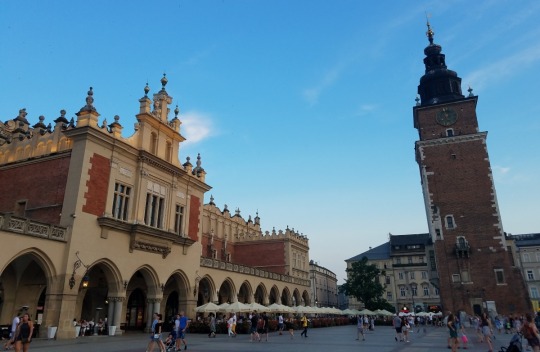
Today, after two and a half months in (mostly) English-speaking countries, it was finally time to dive back into continental Europe. And we'd be diving pretty deep--all the way over to Poland.
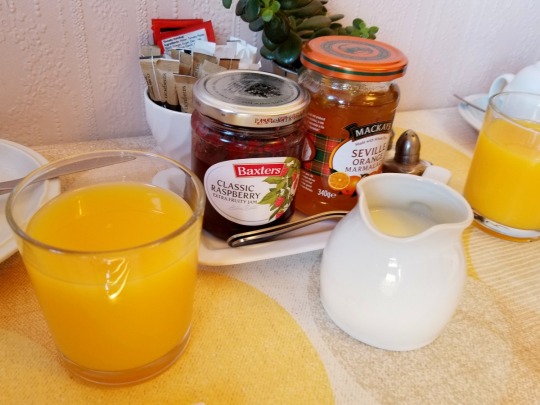
After our last British breakfast, we took a taxi out to the Inverness airport. Our flight was at 10:55, and our host had recommended leaving at 8:30 to make sure we had plenty of time.
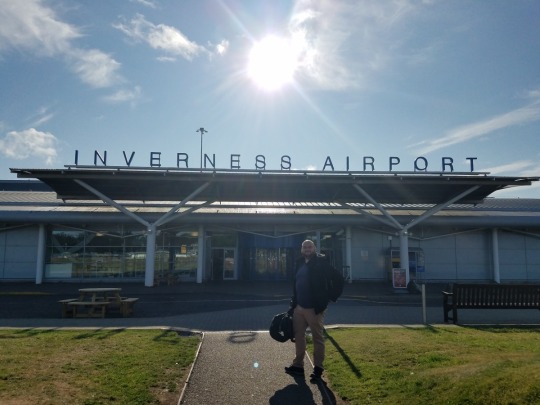
Back when we first arrived in Scotland, we'd thought that flying out of Dublin was as easy as it could get (not counting the Burger King incident). But Inverness was on another level. Checking in, dropping off our bags, and going through security took less than 15 minutes total. That left us plenty of time to browse the airports impressively stocked whisky shop and admire the airport's three gates. Not three terminals--three gates.

Our flight was with KLM Royal Dutch Airlines and included a layover in Amsterdam. We were a little nervous about the layover because it would only be 35 minutes long. But the tickets had all been booked directly through KLM, so we figured that we could trust their judgement.
It worked out, but I’m not so sure about their judgement.
Our flight from Inverness actually left early, and we arrived in Amsterdam over ten minutes ahead of schedule. Which was a very good thing, because we were at the far end of one terminal while our next flight was at the far end of the opposite terminal. And half of the moving walkways were out of service. And we had to go through passport control.
There was a fast-track lane for short connections at passport control, but an attendant told us to go into the main line anyway. This wasn’t an Inverness or even a Dublin line–this was a major-international-hub line. After waiting in this line for about ten minutes, our mental math was raising red flags. We would have a hard time getting through the line before our flight took off, let alone getting all the way to the gate, which was still a considerable walk beyond the passport control desks.
Just as we were getting ready to ask again, another attendant came up and shouted for us to get over into the fast-track line.
Passports stamped, we speedwalked straight to the gate, bypassing several badly needed bathrooms, and only just made it to the gate at the scheduled opening time. If our plane from Inverness hadn't arrived early, we might not have made it to our gate even if we hadn't gotten stuck at passport control.
Luckily for us, our next plane was also late, so we had time to use the toilets and grab a cold beverage from a vending machine before hopping on the bus that took us to our plane. It was smaller than the plane we took from Dublin to Edinburgh, but it did have jet engines instead of turboprops–so I still count it as an upgrade.
The flight was smooth, and soon enough we were stepping out into Krakow's John Paul II Airport. We decided to get some Polish Złotys (pronounced “zwah-tes”) from the airport ATMs (or "Bankomats") before hailing a taxi from into town. We ended up withdrawing way more money than we needed--the interface had been designed to make it look like you couldn't pull out smaller amounts unless you looked closely.
As it turned out, we probably would have been better off skipping ATMs in Poland altogether.
I always imagined Eastern Europe as a very cash-based place, but that couldn't have been further from the truth--at least in Krakow. Everyone there seems to use credit cards for everything. Spending the 100zł bills that we'd gotten from the ATMs (worth about $25 US) was nearly impossible. Even at large grocery stores and tourist sites, the cashiers would just shake their heads and smile at us condescendingly as if we were simpletons trying to pay with rocks.
We eventually went looking for a bank or currency exchange that would break some of our larger bills for us and gave up after a frustratingly unsuccessful hour of searching. Two of the currency exchanges (or "kantors") practically laughed us out of the doors.
I have to admit that I got angry once or twice over this odd phenomenon. There are ATMs everywhere in Krakow. How is it possible that everyone is using them when the money they dispense is worthless?
It actually seemed like there was a shortage of small bills and coins going on. When I tried to buy 41zł worth of groceries with a 50zł note, the cashier was visibly distressed at the prospect of having to scrounge together 9zł in change. When Jessica managed to rustle up a 1zł coin from her wallet (bringing the change to a single 10zł bill), the cashier's face lit up with relief and gratitude.
All of this wouldn't have been a much smaller deal if my credit card hadn't stopped working back in Scotland. We never figured out why, but at some point my credit card's chip had gotten corrupted and slowly started working less and less reliably. By the time we reached Krakow, it had stopped working altogether. I eventually got comfortable using Android Pay at places that took it, but Jessica ended up making most of our in-person purchases for the remaining two months of the trip.
But all of that was still ahead of us in the coming hours and days. For now, we happily made our way to the airport taxi stand with cash in hand and got a ride into town.
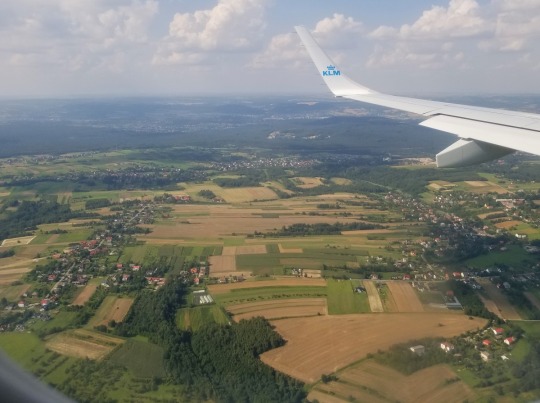
The first thing that struck me about Poland–and I noticed it from the airplane window before we even landed–was the totally unique landscape. I’ve seen forests, farmland, and urban sprawl before, but never mixed together quite so thoroughly. On the 30-minute drive from the airport into town, we passed through dense forests, low-density farmland, and a wilderness adventure park. Even in the suburban periphery of the city, apartment blocks are separated by cornfields as well as vacant lots.

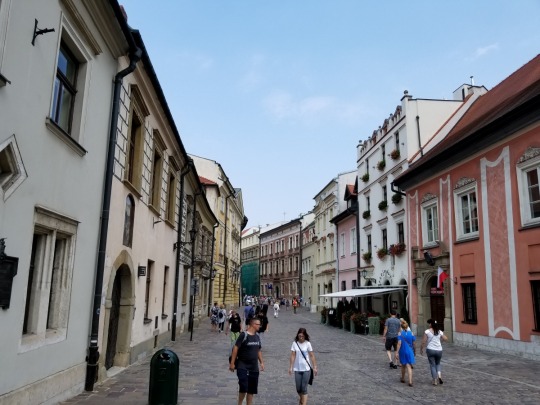

This patchwork aesthetic extends to the architecture of the old city itself. On any given street, the buildings form a mosaic that tells the long and turbulent story of Poland’s past, from the middle ages through the 21st century. Many struck me as ironically eastern European, with inward-sloping buttressed walls and steep, almost pagoda-like roofs. Others looked straight out of Renaissance Venice or Imperial Vienna. And, of course, there are the Brutalist mementos of Soviet austerity.
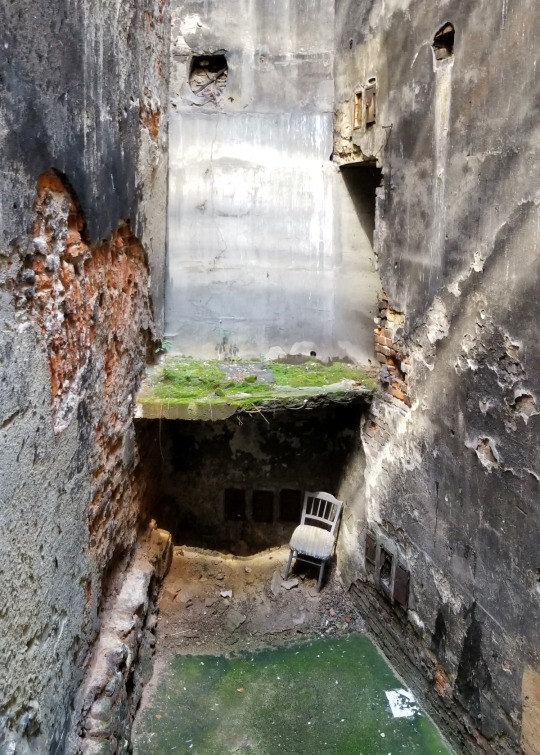
What holds it all together is a charmingly rough-around-the-edges spirit of making do with what you have. Concrete walls patched with plaster, plaster walls patched with plywood. Walking down an alleyway between two buildings, you might tread on tile, cement, and gravel all in the space of thirty yards.
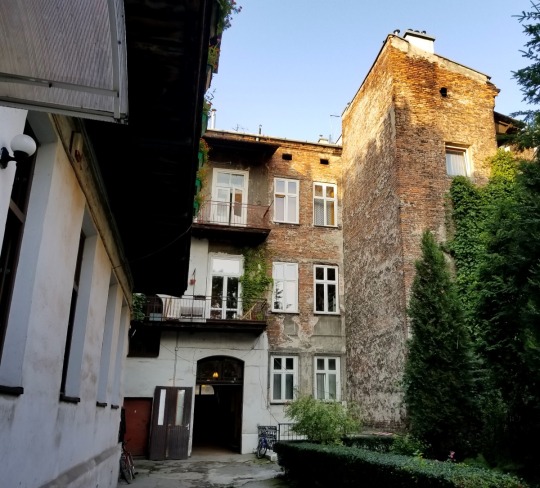
But this is not a third-world country. Enter into one of these unassuming domiciles, and you might find a surprisingly luxurious abode.
Like ours.
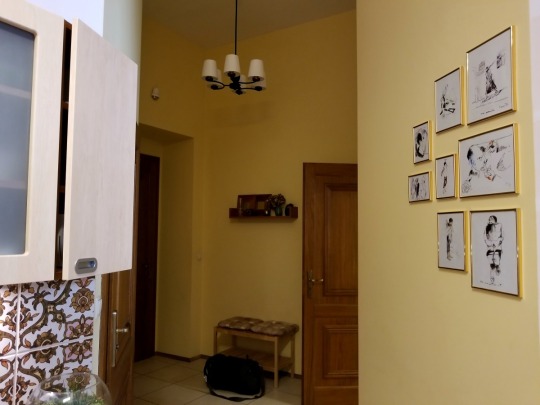
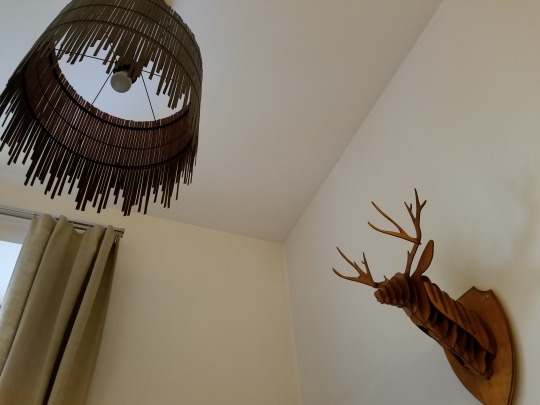
Poland is not a wealthy country. But that means that a little money can go a long way. And while you may trip on a pothole or slip on a patch of sand outdoors, you can come home to a bathtub bigger than any I’ve enjoyed in the States.
The second thing I noticed about Poland are the people. They are both the most reserved and the most outgoing people I’ve met in Europe.
Professionally and in public, everyone is just a blank face in the crowd. Our taxi driver from the airport did not make a single attempt at small talk the entire ride (not that I’m complaining!), and shopkeepers have no trouble flatly declining to assist you if you ask for something they don’t want to do.
But if you engage them personally, as a friend, guest, or tour companion, you’ll have trouble getting a word in edgewise as they talk your ears off with kind enthusiasm, sincere questions, and thoughtful advice.
Obviously, this is a stereotype and doesn’t apply to everyone in Poland. But it’s exactly what Jessica–who spent a summer here in 2010–told me to expect, and it’s exactly what I’ve experienced.

Another funny quirk is that two of Poland's biggest chain stores are named after animals. The main supermarket chain is called Biedronka, which means ladybug, and the main convenience store chain is called Zabka, which means frog.
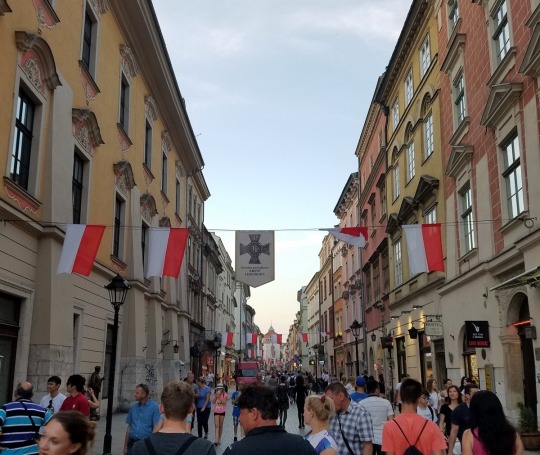
After checking into our Airbnb and stocking up on groceries, Jessica could hardly wait to take me into the old town. Rick Steves says there isn’t a better city in Europe for just wandering around in, and I can’t say I disagree.

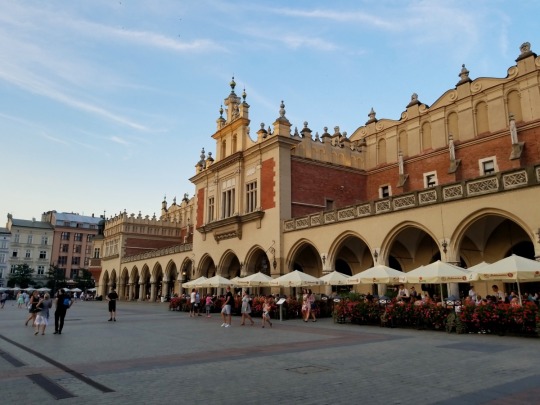
The main market square is spectacular–like Venice’s San Marco Square and Madrid’s Puerta del Sol rolled into one.
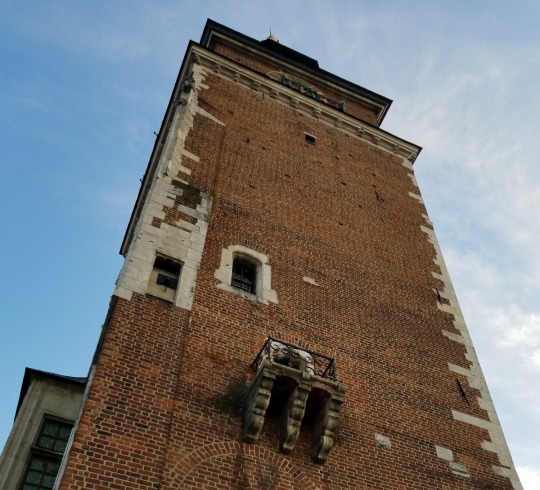
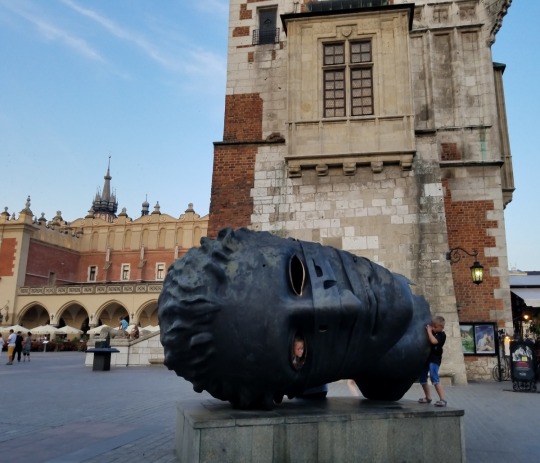
The old Renaissance merchant hall dominates the center of the square, and St. Mary’s Basilica stands proudly overlooking its northern corner.

Technically, the church only has one tower. The taller tower on the left–the one with the crown encircling its spire–is officially a city watchtower. According to legend, a 13th-century watchman was struck silent by an enemy arrow in the middle of trumpeting an alarm. Now, every hour on the hour, a trumpeter plays the same traditional anthem almost but not quite to completion in his honor.
The curtailed call is also used by the Polish national radio broadcaster, so it is a familiar sound across the country.

After taking a peek inside the market hall and up at the nearby clock tower–the remains of an otherwise-demolished medieval city hall–we meandered up the main road to the barbican gate–one of the few remaining parts of Krakow’s medieval walls.

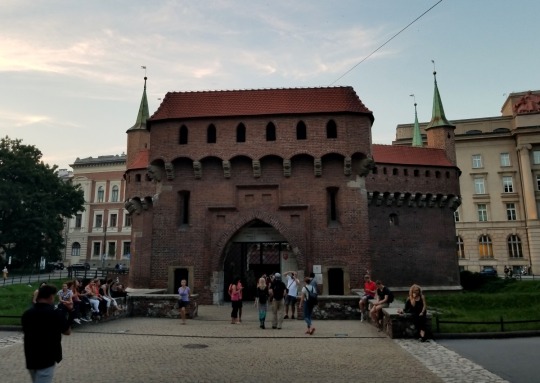
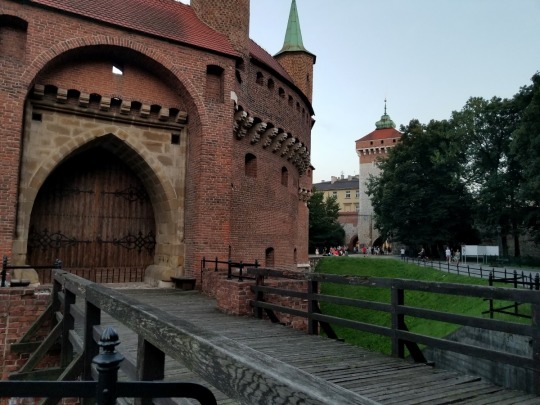
Unlike the many European cities that turned their medieval walls into ring roads, Krakow turned their walls into a green belt surrounding the old city center. Like many Polish names, it was unintentionally amusing to us as English speakers--Planty Park.
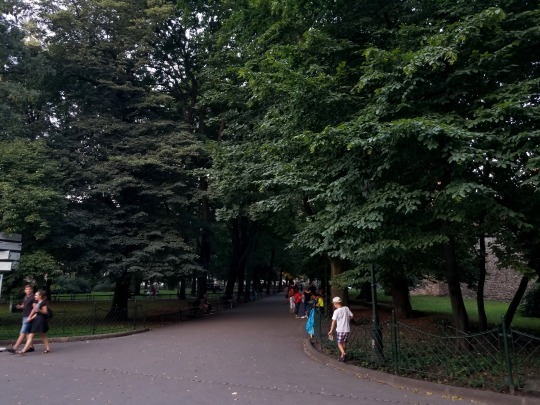
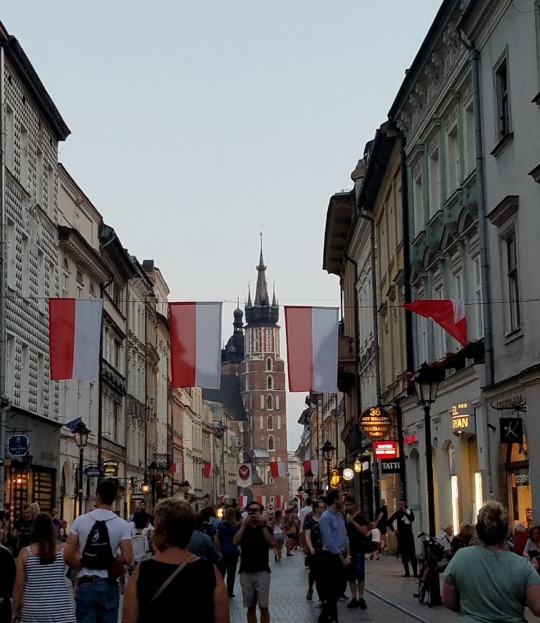
As we walked back down the main tourist drag, Jessica noted how much the place had changed in just the past eight years. A local café she'd wanted to take me to had been replaced by a Starbucks, and there were a lot more ethnic restaurants than she remembered seeing before. Though not all of them looked especially authentic.

Tired and thirsty, we headed back to our flat after stopping for drinks at a Zabka along the way. It was a warm night, but thankfully the windows were big and opened wide. As much as I had feared a culture shock, and our currency-related annoyances notwithstanding, our arrival in Poland had been surprisingly smooth. We were comfortable, well-fed, and excited to see what the city had to offer.
Next Post: Schindler’s Factory and St. Mary’s Basilica
Last Post: Resting Up (Markets, Museums, and More Pizza)
1 note
·
View note
Text
Dublin down
Made it to Dublin last night and took a bus into the city. Had unfortunate adventures in getting a cab, but eventually figured it out. Checked in at the Maldron Hotel on Kevin St. and had dinner there - it was late and we were tired. Today, we explore!
We started with breakfast at hotel, where P was annoyed by the literal busload of American senior citizens. (We really have been surrounded by Americans at every turn, 95% older than us, 80% from Florida.)
St Patrick’s Cathedral is about a block from the hotel, so we started there. P was not greeted as a VIP (rude), but the church was beautiful. We also walked through the gardens out back.
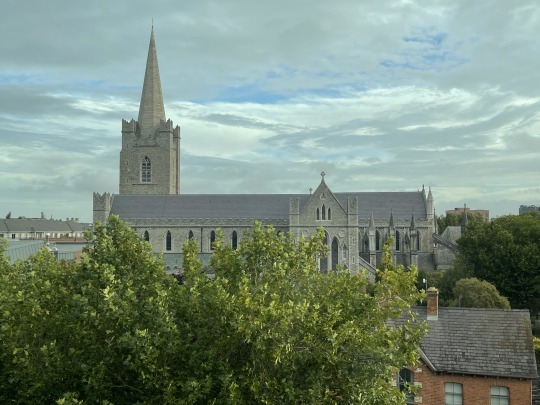

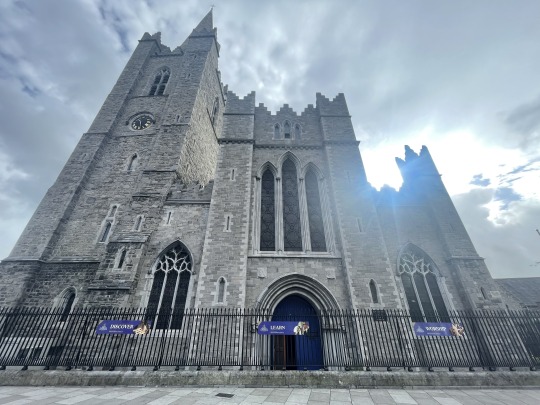

Christ Church was just a few blocks away, so we walked even though it was starting to rain. In addition to the beautiful architecture and stained glass, other highlights include the mummified cat and rat that were found in the pipe organ during renovations. Oh, also the heart of St Lawrence O'Toole, an archbishop who died in France in 1180, and his heart was brought back to Ireland in a heart-shaped reliquary (fancy box), where it remained in Christ Church until 2012, when it was stolen, and subsequently recovered. Weird. Down in the crypts, our fave was da two dudes (our name). Also odd is the Tomb of Strongbow (d. 1176), which is not the tomb of Strongbow, but looks like the Tomb of Strongbow would have looked if it had not been damaged when the south cathedral wall collapsed in 1562. It is unknown who is actually in this tomb, but the family crest on it is not that of Strongbow.
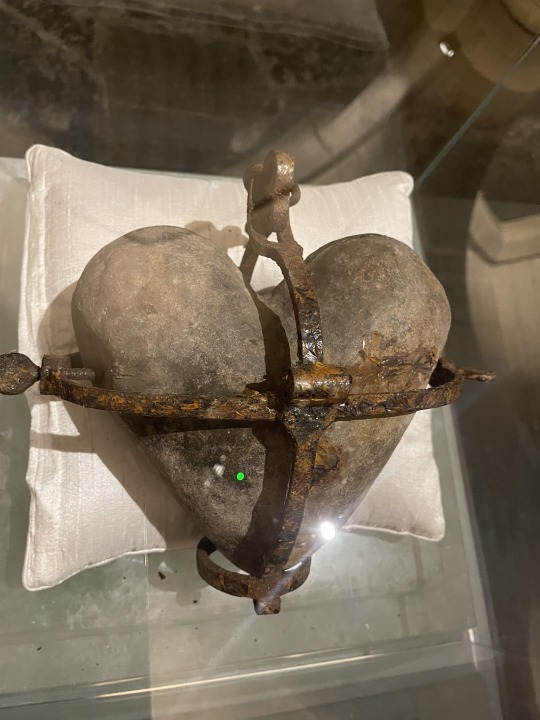
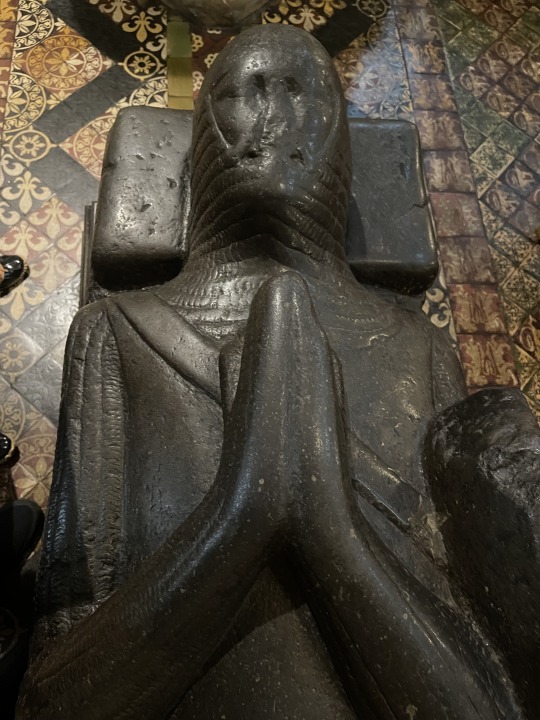
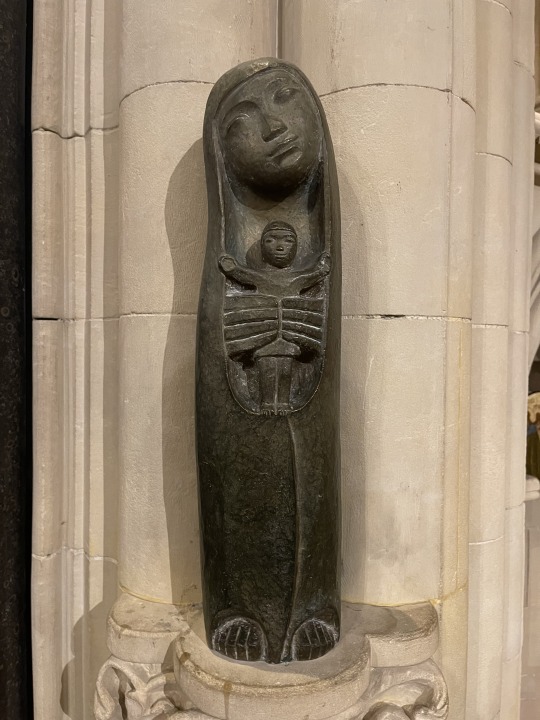


Then we walked to Dublin Castle, which from 1204-1922 was primarily used as a residence for the Viceroy of Ireland, the representative of the British monarchy. Today, it is a museum, and it is still used for ceremonies and government functions.
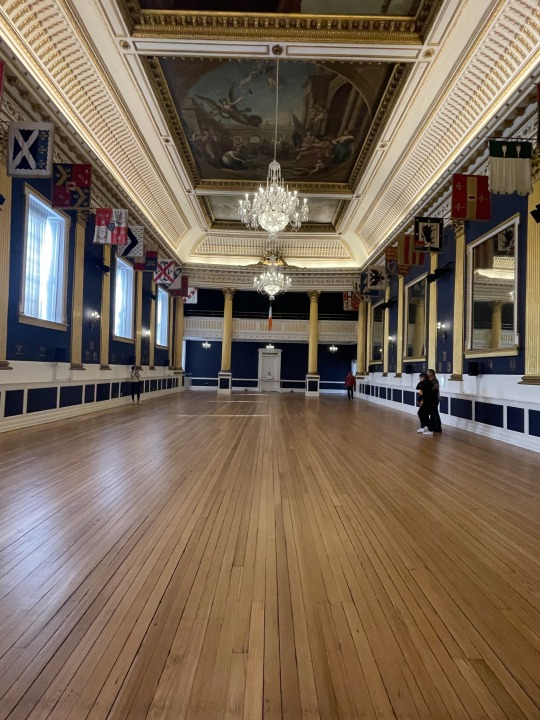
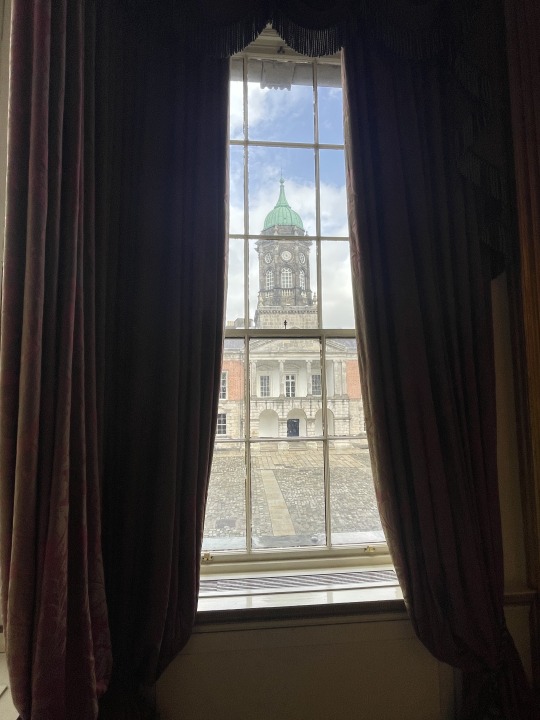

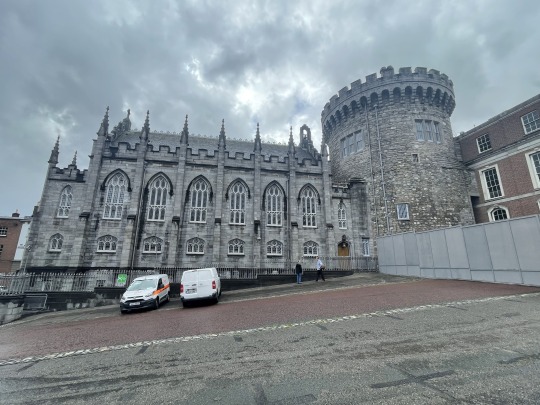
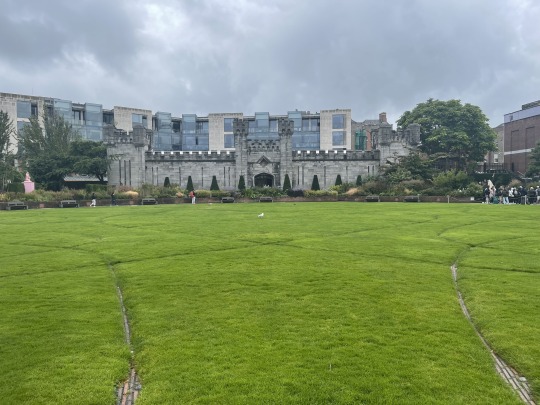
It also has lovely gardens in the back with some interesting art. We think this is the head of Apollo, under the foot of Nike (see swoosh), but Nike is traditionally female. But gods are all-powerful, so I assume they can also be fluid in their gender presentation; we'll go with Nike.
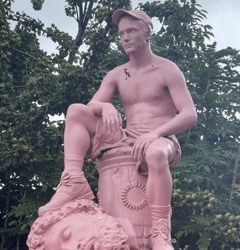
Then it really started raining, so we got on a hop-on-hop-off tour and drove around the city for a while. We couldn't see much because of the rain, but we drove through part of Phoenix Park, past the Dublin Zoo, the US Ambassador's residence, and Áras an Uachtaráin, the residence of the President of Ireland, built in 1751. If it looks a little familiar, that's because the White House was modeled after it. Central Park was also modeled after Phoenix Park. Americans tend to think we're the first and best in everything - it's good to get knocked down once in a while visiting sites and buildings that have been in use for thousands of years.
Quick break at the hotel to change for dinner, then walked through the St Anne's district and down Grafton St to see the Phil Lynott statue (hi, Big Jeff!) Then on to O’Donoghue’s to look for Badger’s 1019 dollar and Kate's Paddy, but to no avail. This guy is not him, but he is named Paddy. (NOW how does it feel seeing your name everywhere, including on every third guy in town? 😂 ) Paddy also served us our first Guinness in Ireland.

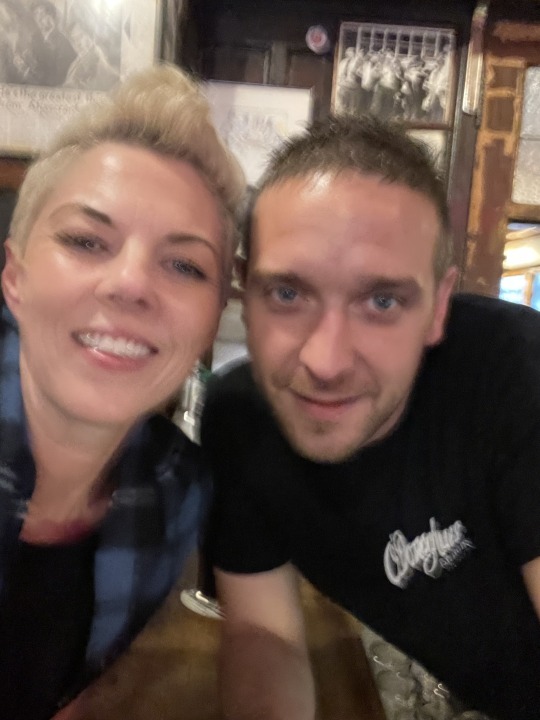

Met Tara & fam for dinner at Thunder Road Cafe in Temple Bar. Her girls are lovely, and Gareth is a force to be reckoned with; he conquered the F#@k Burger and was awarded a t-shirt to prove it. They only had women's sizes left, but he's a sport and wore it with pride.

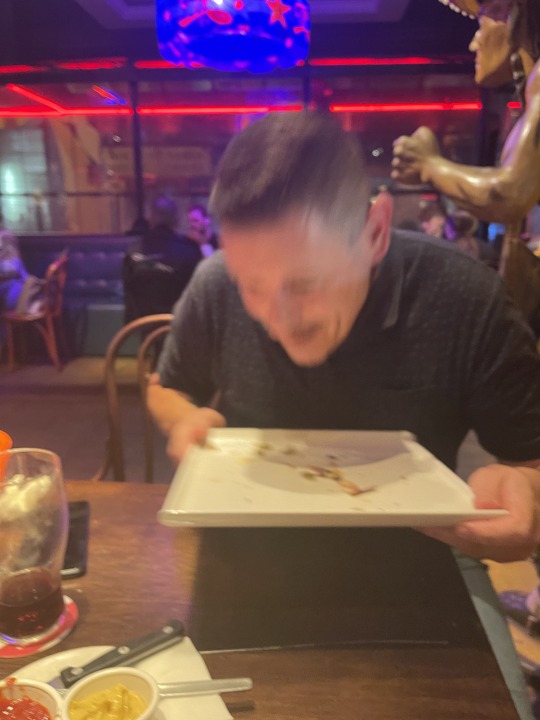
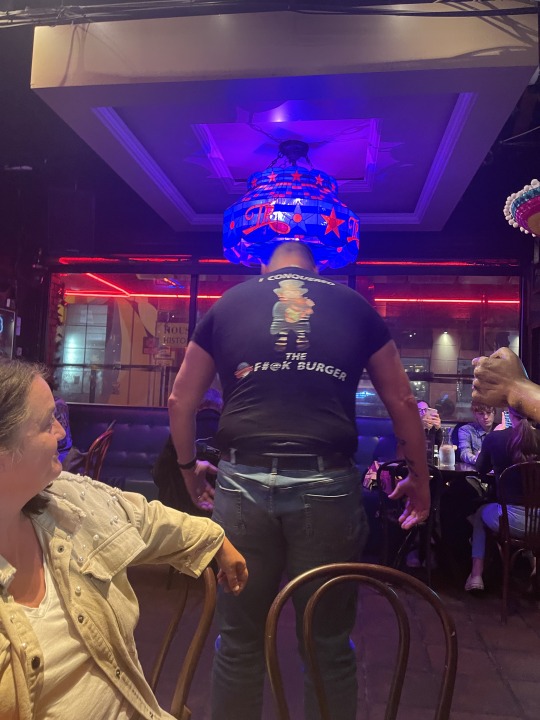

Drinks after at the Foggy Dew (I t’ought dey was sayin’ Foggy Jew 😧). They gave us a ride home, and we inexplicably got stuck in the parking garage for 15 mins. It gave us a chance to visit a little more, but we were all glad to get out.

0 notes
Text
galway, ireland
22.3.2018
I woke up at 6:30 to inhale three croissants and some cheese and go to the airport. Prague airport is really weird because you check in, go through passport control, go through all the shopping, and then you sit in the terminal and wait until about an hour before your flight before going through security. I also think that lemon Pepsi will be my new “waiting for a flight” drink because it’s so good and the only place I’ve seen it so far is in the airport.
Upon arrival in Dublin, I got some water and a vegetable and mozzarella “toastie” (hehe) and went to find my bus to Galway. I’ve already noticed so many differences between Prague and Ireland and I’ve been here for less than an hour.


After the three hour ride to Galway, I met Alyssa at the bus station and we basically went straight to dinner.

Galway is the third largest city in Ireland, but it really has a small town vibe more than a city one because there’s only about 75,000 people. It’s perfect. For dinner I had chicken kiev, and it was delicious and full of garlic. I also tried “brown sauce” for the first time. I dipped some fries in it, and it tastes like if you mixed a teeny tiny bit of ketchup into a lot of apple cider vinegar....I stole some packets to take back to Prague. AND the water was free and cold.

There’s so many cute little canals and rivers and waterways around Alyssa’s apartment (which is the nicest student apartment I’ve ever seen, might I add).

When we got back, Alyssa did my makeup for fun, we relaxed for a while after my journey, and then we went out for drinks in some Irish pubs. We jumped around for a while listening to a bunch of different live music (which is so lighthearted and fun and in every bar).

By the time we made it out of the apartment, the live music scene was winding down, so we walked around Galway at night. We saw some beautiful things and had a great time. We also got some BIG pizza!!!



It was a great first day.
23.3.2018
We ate some bagels for breakfast, and Alyssa took me to her school to show me the campus. It was beautiful, and it was also kinda nice to be on an actual college campus separated from the rest of the city for a little while.



We then walked the short distance to the Galway Cathedral, which is the last great stone cathedral to be built in Europe. Unfortunately, we weren’t able to go inside because there was a mass going on when we arrived.


We went to Tesco to buy some snacks for the next day, went back to the apartment to drop them off, and walked around town stopping in different stores and showing me the city in the daylight.
I also got to go into TK Maxx and felt at home a little bit. Miss you, TJ Maxx!!!!!!!
After that, we got some coffee at a cute little coffee shop and ventured home, making a pit stop at the Spanish Arch (sparching: sitting along the water at the arch) and strolled on a part of the Long Walk (thanks to Alyssa and Ang and the entirety of Galway, I can’t type that out or think of Galway at all without thinking of this song, but tbh, I’m not mad about that at all: https://www.youtube.com/watch?v=i3V-oXwCWL4).









We got some garlic bread on the way home, went to take a lil snooze, ate some soup and grilled cheese for dinner, and decided to go out to a bar/pub again after. But first, look how cute this little canal spot is.

Here’s a nice picture of me, Alyssa, Ang, and my new pal Katie.


My first Guinness (both in Ireland and ever)!

This was a super fun night because the live band was incredible and sang songs we all knew, and there were a couple of Irish girls who made us all dance with them. It was a lighthearted and almost spiritual even. Ethereal, you could say, if you said it in the right tone.
After we left, we got the most amazing pineapple pizza with ranch dip (the best in Europe!!) and went to bed.
24.3.2018
Surprise, we ate bagels for breakfast again!! We met up with Alyssa’s friend Lauren and we all headed to the coach station to get on our tour bus for the Cliffs of Moher and a few other destinations.
Our first stop on the bus tour was the Dinguaire Castle from the 16th century.


Alyssa is good at almost falling.

We got back on the bus and took some cute cow pictures through the window on our way to our next stop.

The next stop: Poulnabrone dolmen.


Next: The Celtic High Crosses. It was unsettling to have to walk and jump over graves to get to them.



After that, we had a break for lunch in the teeny tiny town of Doolin. I got bangers and mash, which was even better than I imagined. We also had a couple of minutes to go in some small shops and take some pretty pictures.





Finally, what we’ve all been waiting for, we arrived at the Cliffs of Moher. I am not exaggerating when I say that the cliffs were the most beautiful thing I’ve seen in Europe so far this semester. We really lucked out with this beautiful warm sunny day considering Ireland is usually at least cloudy if not rainy and windy. My words don’t do the cliffs justice, and the pictures barely do either.






You know we had to give my mom a heart attack (don’t worry, I was actually standing on a ledge, sorry to ruin the illusion).




OK here’s the cutest little wet floor sign in the bathroom at the bottom. I’m obsessed.

Our final stop on the journey back to Galway included a stop on the Burren where the ground looks like the surface of the moon.


When we finally got back, we were chilly and tired, so we got some pasta from Pasta Factory and went back to the apartment to eat that and cookies. We were going to lay down for a bit and get up to do something else, but we ended up crashing at like 8:30 pm. I don’t blame us, it was a long day on the bus.
25.3.2018
We woke up after a long night of sleep even though we lost an hour for Daylight Savings, and we went to walk around town in the morning waiting for brunch places to open. How CUTE IS THIS PLACE?!





I’d been craving pancakes and bacon and a smoothie for as long as I can remember, so thank gosh for this delicious place. I’m getting hungry again just looking at this picture.

Alyssa then walked me to the coach station and we said our goodbyes. I got to get on a bus an hour earlier than what I paid for because my flight was scheduled to leave earlier than I thought it would. I’m grateful for the kindness of Irish men who work for this bus company. The three hour ride was fine and seamless, but the Dublin airport is one of the most stressful ones I’ve been in so far. I’m glad I got there earlier. It was a long day of traveling, but it didn’t feel like it because everything was fine and Ireland is beautiful.
My last picture I took in Dublin, Ireland before getting on the plane home to Prague (miss you sweetie).

I think that if I had the opportunity to study abroad again after Prague, I would choose somewhere in Ireland. It was so fun, relaxing, beautiful, and full of nature and nice people.
Differences between Ireland and Prague:
Everyone I encountered in Ireland in the first hour of me being there has been incredibly kind, even when their jobs are typically those who get negatively stereotyped as being miserable, such as passport control, bus drivers, fast food stops in airports, etc.
They drive on the other side of the road. I knew it when I booked the flights, but it’s a weird concept to see in real life.
A total stranger asked me to use my charger on the bus and then called me a “fine woman” when I said she could. People in Prague don’t even look at me!!
Night life is so pure and good. There’s live music everywhere and everyone is happy to be there and everyone dances with everybody.
Alyssa’s school has a designated campus. My school in Prague is extremely integrated into the city, while hers feels like a separate community in a way.
Prague uses bars as social gathering points to sip on beer and talk to old friends, while Ireland uses bars and pubs as places to drink a lot and dance with new friends. Both are great!
They all speak English, and I love the Czech language and I think I’m picking up some phrases relatively well, but it is so refreshing to hear English everywhere.
I’ll be back, Ireland!
2 notes
·
View notes
Text
Hello all!
It’s been a long while since I’ve written up a proper blog post on here. I’m most active on my instagram these days, but I’m going to make an effort to post more regularly on my actual page as sometimes I find I cut recipes short to fit them all into the Instagram/Facebook format etc.
I was recently in New York and pretty much centered the entire trip around finding all the good foodie spots, so I figured it deserved a lengthy post! We tended to eat a late brunch and dinner most days, skipping lunch as our hotel had a free snack bar which was very handy. They had fresh fruit, lovely coffee & granola bars in the morning which were great to grab n’go. The options changed from lunch time and included savoury snacks and sweet treats with limitless soft drinks, fizzy water etc. We stayed in the Club Quarter Hotel Midtown near Times Square. It was a brilliant location, lovely room, great value, nice staff and the unlimited snack bar with filtered water on tap was such a bonus. They even gave little bottles to take your water with you! Hotel website linked here.
So, without further ado, here are all of the foodie places in New York during my trip. Hope anyone travelling to NY finds it useful! Thanks to everyone who recommended food spots to me before I went – you all helped to make my trip deliciously good and my foodie self is eternally grateful!
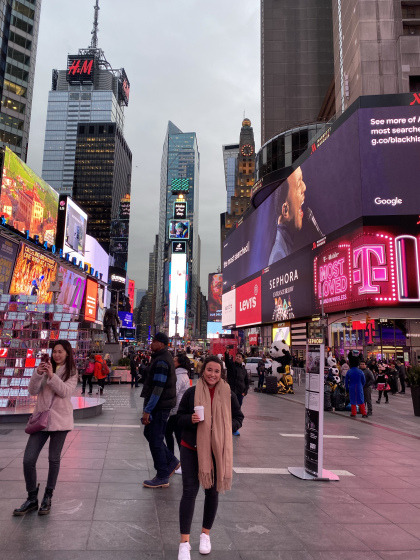
BRUNCH
Bubbys – Easily the single best brunch I have ever had and was the food highlight of the trip for me. We went to the one in Tribeca but they have a few locations. We got the Eggs Benedict and ‘Pancake Flight’. The Eggs benny was to die for, we opted for the version with bacon and added some avocado to it. The pancakes were also EPIC. Super fluffy & thick, they came with berries, nutella, blueberry compote, whipped cream, caramelised banana and toasted walnuts. They also came with maple syrup and butter on the side without even asking – it was a lovely touch. The total bill came to about $60 including a tip and we didn’t get coffees/drinks, only tap water. I honestly can’t wait to go back to NY to have Bubbys again, it was just that good. Bubbys is a definite must! Website here.
@bubbys
Sarabeths – This is super near to Central Park. We had seen on their instagram that they are famous for their french toast so that’s what we went with. For $50 we also got a caraffe of Bellini’s – it’s about 5-6 glasses which were $15 each so it’s good value really ;). I ordered the Almond crusted French toast and my friend went for the ‘Fluffy Fat’ french toast. We also ordered a side of bacon (additional $12). I will say I was quite disappointed with my almond version as when I cut into it, it was actually bone dry in the middle. The whole point of French toast is that it should be eggy/custardy having been soaked in an egg mixture but this was essentially dry almond toast. They were very good and immediately replaced it with the plain version that my friend had ordered. This was absolutely delicious and came with a side of butter and maple syrup. The service was great here and I would definitely recommend the Fluffy Fat french toast and skip the almond version! All in all the bill came to about $115 excl tip. Pricey but it is in a great location and overall the food and drink was lovely. Website here.
@sarabethsnyc
Fresh & Co – We definitely couldn’t leave New York without trying a cream cheese bagel! I had lots of places recommended to me, but we happened to be passing by here and were stuck for time so we just popped in. It wasn’t on the menu and breakfast had just finished, but they made these specially up for us which was really nice. We asked for 2 wholemeal bagels, filled with cream cheese, avocado, crispy bacon and a runny fried egg. We got freshly squeezed orange juice to go with. It was honestly *so* good and hit the spot. Great place to call into if you just want something quick to eat & go. I think it was roughly $12 for the two bagels, with orange juice about $5 extra incl taxes. They have quite a few locations. Website here.
@freshandconyc
DINNER
Ellens Stardust Diner – This place is pretty much as American as it gets. It’s a diner set in the heart of Times Square, waited by Broadway hopefuls who sing and perform throughout the entire meal. They are also famous for their brunch. We headed here our first night and ate dinner here. We went for the Mac n Cheese burger, served with waffle fries. We then shared a Brownie ‘Mudslide’ Sundae for dessert. It was typical American diner food, it was decent and hit the spot but you definitely more so go there for the surroundings than the food. Total bill was about $60 excl tips but be mindful, they send around a separate bucket for the tips for the singers too. Website here.
@ellensstardust
Ottos Tacos – We got these the night we went to Woodbury Common Shopping outlet. It was such a long day and we were absolutely shattered when we got back to our hotel, so we ordered Uber Eats. We opted for a ‘Beyond’ Vegan chorizo taco, chicken taco, chips & guac and rice and beans. The chorizo taco wasn’t great but all in all was a tasty meal and perfect for a late night nibble. Uber eats is super handy if you’re stuck on time/tired and they have no problem delivering to hotels, they had a huuuuge selection of foods available. Website here.
@ottostacos
Otto Pizzeria – We had a lovely dinner at otto pizzeria. We originally wanted to get to Joes pizza which I’d had lots of recommendations for or Scarrs… however otto was closer by and Joes had queues out the door! I opted for a delicious egg pizza washed down by blood orange cocktails. We actually arrived half an hour earlier than our booking and they were lovely about it and immediately seated us. We also got complimentary focaccia & olive oil to start! It did the trick but definitely still have Joes & Scarrs on the pizza list! Website here.
@ottopizzeria
BAKERIES
Levain Bakery – I went to the one just off central park. I had heard a lot of hype about this place. They are famous for their super thick gooey cookies and sweet jesus, they did not disappoint. Some of the best cookies I’ve ever had. All made better by eating them while strolling on lovely sunny day in central park. You wouldn’t even know the bakery is there – it is tiny and down these little steps, I had to ask a local where it was as I couldn’t find it! There was no queue when I was there thankfully, but be mindful of this as apparently there is usually a big wait. The cookies were $4 each and worth every bit and more! Their hot chocolate looked epic too so will definitely be paying here a visit the next time I’m in New york to get it! Definitely put this place on your list. Website here.
@levainbakery
Magnolia Bakery – If you are a fan of Sex in the City, you’ll be familiar with this place. It is just around the block from Carrie Bradshaw’s famous apartment and the bakery featured in the TV show a couple of times making it an instant hit. They are famous for their banana pudding – a creamy pudding filled with banana, sponge and graham crackers. I opted for the small pot (as I was stuffed but couldn’t not go to NY and not try it!). It was absolutely insanely good. I think it was about $5 incl tax and worth it for sure. Next time I’m going to try their cupcakes as I’ve heard they are amazing too. Website here.
@magnoliabakery
Carlos Bakery – If you’ve ever watched Cake Boss, here is a must visit! We went to the one near the Port Tunnel (where we got our bus from to Woodbury Common. We actually got a great deal for this on groupon, I’ve linked it here) The original one is in Hoboken and I believe is worth a visit too! The bakery itself was full of a mix of treats, a lot of artificially coloured american style cakes which wouldn’t be my thing, but their pastries, cookies etc all looked amazing. We were spoiled for choice. M\y friend got an M&M cookie which was really tasty and I got a chocolate hazelnut lobster tail pastry filled with delicious hazelnut creme patisserie and drizzled with nutella. So good. All in all they both came to about $11 dollars. The perfect breakfast to bring on board the 1 hour bus journey! Bakery linked here.
@carlosbakery
OTHER BITS…
Airport Lounge – 51st & Green in Dublin Airport terminal 2. We opted to pay into the lounge before our flight as we had a few hours to kill. It was definitely worth it in my opinion! It was located after pre clearance for the US so it was lovely to relax and unwind knowing you had that already done. It costed €39 to get in at the door, but you can book it online for €35. Our flight was in the morning, so they had a full buffet breakfast bar alongside a cocktail bar and coffee station. You can see the lounge by clicking here.
The Plaza Hotel – We were initially going to book ourselves in for afternoon tea here as we’ve heard rave reviews. It was booked out in the end, but we went their for a drink after our brunch in Sarabeths. We opted for 2 x champagne cocktails each $26 excl tax/tips. They were served with a lovely little snack plate of chilli pumpkin seed chocolate and roasted chickpeas. The cocktails were amazing and the setting was just fabulous. It is pricey, but 100% worth it. We sat in a window seat and watched the world go by, just taking in the surroundings for the afternoon. It was such an activity fulled break, it was lovely to just relax for a while and unwind. Would highly recommend it and I think I would definitely try the afternoon tea the next time I visit! Website here.
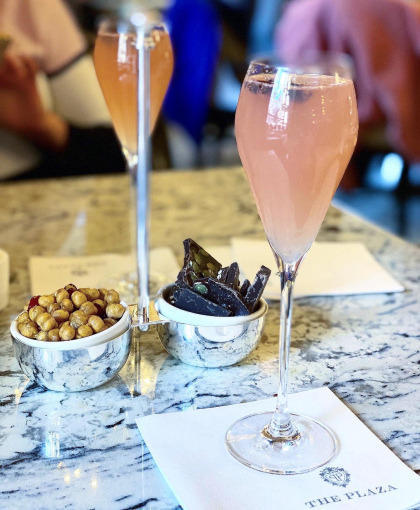
@theplazahotel
Tourist Attractions – I figured I may as well pop in the places we went while I’m at it. We pretty much ticked everything off the list except visiting the Brooklyn Bridge and the Highline… next time!
Statue of Liberty – We got a free ferry from Manhattan to Staten Island. You don’t need to pay for the tourist ones and they will try the hard sell to push it on you at the door of the terminal but stand your ground! You can get the commuter ferry for free from Whitehall which goes right past it and you get a very clear view. We just hopped off at the other side and got straight back on it. Took 20 mins – they go every half an hour. Would definitely recommend. Info link here.
Carrie Bradshaws Apartment – Quite near the Statue of Liberty area, about 20 mins in an Uber. It was so cool to see as a SATC fan. It was also just around the corner from Magnolia bakery. Be mindful people actually live in the Apt block when you’re taking photos. Location is here
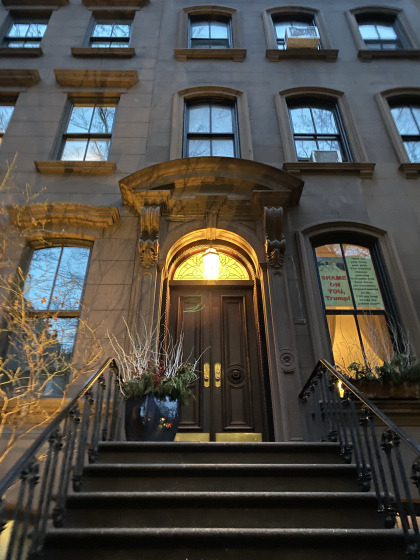
Ground Zero – We went here en route to statue of liberty as it is quite close by. It was also quite close to Bubbys in Tribeca. We just went to see the memorial which is free but you can go into the museum too. There is a great shopping mall and discounted designer department store nearby called Century 21. Worth a visit too. There is also a target nearby if that’s something you wanted to browse!
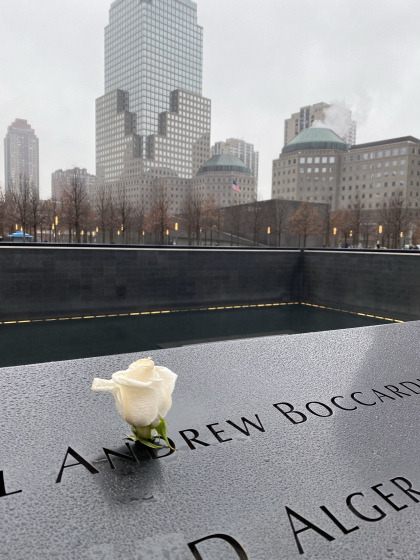
Rockefeller Centre – Top of the Rock. We paid about $42 for the ticket to get up. We bought online but they have a ridiculous queue system where you need to validate your online ticket to get a physical one, so the queue was the same for those who didn’t buy online and it cost the exact same. Be prepared to queue, we waited almost an hour to get up but we were told it was unusually busy as it had been raining the 2 days previous. However, the views are absolutely spectacular when you get up, so it was well worth it in the end. You can go at sunset for an extra $10 per ticket which would also be pretty cool.
Woodbury Commons Shopping Outlet – This place is definitely well worth going to if you are in the market for discounted designer handbags / shoes. The clothes were good value too depending on what you’re looking for but the handbags we’re exceptionally cheap with 60%-80% some items depending on what coupons you had/how much you spent. As I mentioned above, we got the return bus from the port terminal near times square. It was $27 on groupon linked here or you can buy it there for $42 so it’s definitely worth getting it online. It took about an hour each way, with a pretty regular time table. It doesn’t open until 10am so we got the 8.30am coach which worked out great. You also get a free coupon book from the information desk when you arrive which is included in your bus ticket.The food was okay there, had a lot of fast food outlets and a Pret A Manger (they are everywhere in NY!) Definitely a must visit if you’re looking to do some shopping! Link for outlet is here.
Central Park – I was really taken with central park. It is so cool to stroll around (especially with some Levain cookies!). You can hire a horse drawn carriage for a pricy $100 per half an hour or a bike cart for $5 per minute. We were initially going to rent bikes but we didn’t bother in the end, instead walking around and taking it all in. Well worth a look. The plaza hotel and Sarabeths were super near here too.
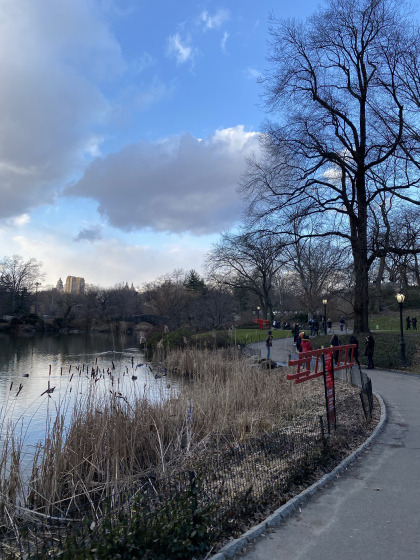
So that’s a wrap! It’s pretty much all I can fit into this post. I hope it’s helpful for any trips you have planned to New York. Please tag me if you visit anywhere I’ve recommended so I can relive the memories… @littlemuffinblog
It was the most epic trip and I will definitely be back! Miss you already NYC.
New York – Foodie & Travel Guide Hello all! It's been a long while since I've written up a proper blog post on here.
0 notes
Photo
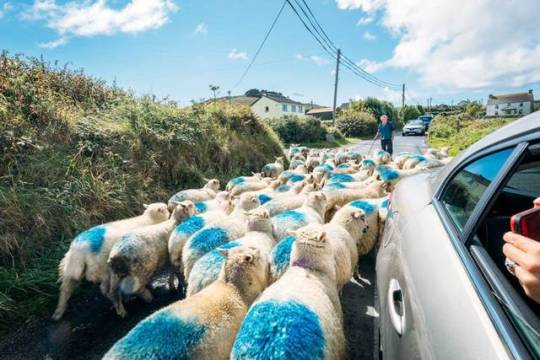
Tips For Renting A Car In Ireland
Ireland Driving Guide
Renting a car in Ireland and driving around the country yourself is a wonderful way to experience the Emerald Isle. But here’s some advice about the best way to do it.
When my family and I were planning our genealogy trip to Ireland to learn more about our ancestors, we were initially hesitant about renting a car to explore the country by ourselves.
Ireland has a bit of a reputation for narrow and scary winding roads!
Plus of course, they drive on the other side of the road, so there’s that. But the more we researched, the more we realized renting a car in Ireland would allow us to make our itinerary as imaginative as possible.
I love the freedom of road trips and planning my own travel itineraries. Ireland is such a diverse country that it made sense to rent a car so we could stop anywhere to discover small villages, castles, and go hiking in the mountains at our own pace.
Here are some important tips we learned from our experience renting a car in Ireland, to help you save money and stay safe while driving around the country!
How To Rent A Car In Ireland
Driving in Ireland for Tourists
Should You Rent A Car In Ireland?
Hey, if you love those big group bus tours, by all means, go book one. It’s a decent way to see Ireland if you don’t have a lot of time.
No planning, no driving, just sit back and let someone else do all the work!
But if you’re like me, you prefer the adventure of independent travel.
No set schedule or timetable — driving around Ireland with the freedom to stop anyplace cool you find along the way.
If that’s the kind of traveler you are, renting a car in Ireland is the way to go!
Just keep in mind that some of the backroads in Ireland can be very narrow, and often feel like a single lane (but they’re not). With some practice, you’ll gain confidence on them!
Another nice thing we enjoyed about having a car was the ability to store things in the trunk, stopping off in Irish towns with small daypacks rather than hauling luggage everywhere.
Learning to Drive on the Opposite Side!
Where To Rent Your Car In Ireland
The best site to book your car is Discover Car Hire. They search both local and international car rental companies to help you find the best possible price. This is the easiest way to rent a car in Ireland.
We rented our car from Dublin Airport after spending a few days in the city. Our South West route brought us to Cork on the M8 before moving on to Killarney National Park and then Glengarriff, where my grandmother was born.
After tracking down our family history in this small coastal fishing village, we drove North on the Wild Atlantic Way up to Dingle and the famous Cliffs of Moher, then to Galway, and finally back to Dublin.
However there are many different road trip routes you can choose when driving in Ireland. Other major airports to consider picking up a car are Shannon in the Southwest and Cork in the Southeast.
Crazy Irish Winding Roads!
The Amazing Cliffs of Moher
Car Rental Insurance In Ireland
Some of the rumors about driving in Ireland are true, and the roads are VERY narrow in areas. Especially the backroads outside Ireland’s smaller towns. Don’t worry, I’ll share some tips for dealing with them below.
This is why I highly recommend getting full insurance coverage.
Typically, rental cars in Ireland come with a basic Collision Damage Waiver (CDW), but this isn’t exactly insurance, and only covers the car for up to €1000-3000 EUROS worth of damage.
This is the amount they hold on your credit card until you return the car in one piece. CDW typically does not include tire, cracked windshield, or undercarriage damage either.
While you can often save money booking your car with a credit card that includes car rental insurance, you REALLY must read the fine print, because many people wrongly assume their card covers them in Ireland.
If you get in a wreck driving in Ireland, declined full coverage, and you suddenly learn your credit card doesn’t actually cover the damage — you’re screwed. I can’t tell you how many travel horror stories I’ve heard like this…
It’s why I usually pre-book full coverage online. It’s cheaper than at the counter — and then you won’t have to worry about accidents at all!
The Stunning Cobh Cathedral
How Much Does It Cost To Rent A Car In Ireland?
Renting a car in Ireland is going to cost you around $25-$40 USD a day, depending on the type of car you get. Our 4 door sedan was about $30 per day.
I recommend renting a car with an actual trunk (no hatchbacks) to hide your luggage from prying eyes. It helps to prevent break-ins if thieves can’t see your stuff.
Gas Prices
Gas (petrol) prices in Ireland might seem cheap to Americans, but remember that the rest of the world quotes gas in Liters, not Gallons (1 Gallon = 3.78 Liters). Currently, gas costs about $5.90 per gallon (€1.40 per liter) in Ireland. Diesel cars will often save you some money on gas.
Automatic vs Manual
Automatic cars are more expensive to rent than manual cars (but manuals are more common in Ireland), and you must specify what type you want when booking.
One-Way Rentals
There’s also an additional fee for one-way car rentals, which can vary by company. For example, if you want to drop off the car in a different city than you started from.
Admin Fee
If you opt to use your own credit card insurance, companies will charge you an “admin fee” of about €30 EURO.
Credit Card Fee
I was charged an extra €5 EURO just for using a credit card. Which is strange to me, but typical in Ireland.
Irish Taxes
Car rentals in Ireland have a very high tax rate of 13.6%. Ouch!
Age Requirements For Renting A Car
The minimum age for driving in Ireland is 18 years old, however most car rental companies enforce their own age limit of 21 years old to rent a car. They also charge an additional fee if you’re under 24 years old.
Driving Through the Town of Killarney
Irish Driving Laws Tourists Should Know
The most confusing part of driving in Ireland for most tourists is driving on the left side of the road — with the driver’s seat on the right side of the car.
If you’ve never been to a country that drives on the left, it’s wise to practice a bit in a small town before you head onto the highways of Ireland.
For example, just North of Dublin Airport is the town of Swords. Maybe spend an hour or two getting the hang of driving there before you enter Dublin or onto the main highways.
While challenging at first, especially if driving a manual, you’ll get the hang of it quickly and will be ready to explore Ireland by car in no time!
The speed limit on local roads is generally around 80 km/h while on national highways it’s up to 100 km/h.
International Driver’s License
No, you do not need an international driver’s license to drive in Ireland or rent a car there. Just bring your passport, credit card, and your driver’s license from your home country.
Ross Castle at Sunrise
Helpful Tips For Driving In Ireland
Watch out for sheep! In many smaller towns, local shepherds move their sheep on the roads. You can easily round a sharp bend and find yourself stuck behind a huge flock walking down the road.
Narrow backroads in Ireland don’t have standard break-down lanes as we have in America. There’s often no room for error or pulling over.
Sometimes your side-view mirror will be inches away from stone walls or hedges while passing other cars! It can make driving here nerve-wracking.
Remember to carry some cash for road tolls on Ireland’s major highways. Irish tolls can cost between $1-$3 for a passenger car.
In the countryside, some roads are truly single lane, but with traffic in both directions. In these situations, there are pull-outs so one of you can pull over for the other to pass.
USEFUL TIP: Buy a cheap “learner” sticker (L) sold at gas stations so locals don’t get pissed off at your incompetence on their roads!
The Colorful Town of Glengarriff, Ireland
Advice For Renting A Car In Ireland
You don’t need a rental car for Dublin itself. Parking can be a pain and Dublin is very walkable with excellent public transportation too.
If you’re starting your trip in Dublin, maybe book a rental car when you’re ready to leave the city, for exploring the rest of the country.
Don’t book a car without reading the company reviews. You’ll find plenty of bad reviews for every company (people love to complain online), but try to pick one with the LEAST bad reviews.
You may not always get the make/model/type of car you booked. If they give you a smaller car, or a manual when you asked for an automatic, be pushy and ask for an upgrade.
Inspect your car thoroughly and record video on your smartphone pointing out damage before you leave. This is a backup if they attempt to charge you for damage that was already there.
Pay attention to if your car takes regular petrol or diesel fuel, so you fill up with the correct type at gas stations.
Use Google Maps on your smartphone for directions. Bring your own hands-free adapter and buy an Irish SIM card at the airport.
Enjoy Your Ireland Road Trip!
Exploring the small villages, ancient castles, green mountains, and coastal cliffs of Ireland in a rental car was definitely the right choice for us.
Self-drive road trips get off the beaten track to see things most people miss! ★
Check Car Rental Prices & Availability In Ireland
Packing Guide
Check out my travel gear guide to help you start packing for your trip. Pick up a travel backpack, camera gear, and other useful travel accessories.
Book Your Flight
Find cheap flights on Skyscanner. This is my favorite search engine to find deals on airlines. Also make sure to read how I find the cheapest flights.
Rent A Car
Discover Car Hire is a great site for comparing car prices to find the best deal. They search both local & international rental companies.
Book Accommodation
Booking.com is my favorite hotel search engine. Or rent apartments from locals on Airbnb. Read more about how I book cheap hotels online.
Protect Your Trip
Don’t forget travel insurance! I’m a big fan of World Nomads for short-term trips. Protect yourself from possible injury & theft abroad. Read more about why you should always carry travel insurance.
Enjoy This Post? Pin It!
READ MORE FROM IRELAND
How To Visit The Cliffs Of Moher The Best Of Dublin Travel Guide My Irish Genealogy Road Trip Claiming Irish Citizenship By Descent
Any questions about driving or renting a car in Ireland? Are you planning a road trip there? Drop me a message in the comments below!
This is a post from The Expert Vagabond adventure blog.
#><div#DCEFF5;border-color:f8fcfd;color:333333;border-radius:3px;-moz-border-radius:3px;-webkit-border-radius:3px;#F7F7F7;border-color:fdfdfd;color:333333;border-radius:3px;-moz-border-radius:3px;-webkit-border-radius:3px;#333333;color:FFFFFF;border-top-left-radius:1px;border-top-right-radius:1px#c6d7dc;border-radius:3px;-moz-border-radius:3px;-webkit-border-radius:3px;>#dedede;border-radius:3px;-moz-border-radius:3px;-webkit-border-radius:3px;>#292929;border-radius:3px>Travel#039;t
0 notes
Text
Day 3 - Enough with the Beer, on to Whiskey
Our last full day in Dublin began with a long bus ride out to Phoenix Park and the Dublin Zoo. But first, we stopped in St. Patrick’s Cathedral, another grand stone monument bursting with history. Alex immediately grabbed Allison’s phone and started snapping pictures of everything he saw–the stained glass window, the tiled floor–amazing she has any storage space left. The walls were covered in memorials to old dead dudes and dudettes, including Jonathan Swift, who was a dean of the Cathedral.
Boarding the bus again, there were quite a few sights along the way from the second deck, including Kilmainham Gaol (a now-closed jail). Sadly, this attraction was entirely booked for the weekend and we completely dropped the ball–a huge disappointment since there was so much rich prison history to learn about (like Lockdown Raw, 1900s style). So if you ever plan to visit, don’t make the same mistake and get your tickets early!
Entering the vast and verdant Phoenix Park, we were informed it was twice the size as Central Park and the largest green space in any European city. Along the way, the weather was partly cloudy and teetered towards wanting to rain at moments, but that didn’t deter us from heading into the zoo. We had few expectations other than to pass the time with a happy child, but we were pleasantly surprised by this fantastic place. The size of the zoo is tremendous and the scenery flows from one type of environment to the next. The diversity of the animals was grand as well–it had all the staples you might expect: tigers, rhinos, hippos, gorillas, chimpanzees, sea lions, flamingos, giraffes–and quite a few animals I had never seen before in the flesh (like tapirs, African hunting dogs, and even a stupidly photogenic red panda). With that much land, all the animals were in exceptionally large and comfortable-looking enclosures.
There were the inevitable play structures and slides around the park which Alex enjoyed (and its essential for us to get to sit down every once in a while)–he finally started interacting with other kids which he hadn’t much chance to do prior. It seemed like the vast majority of visitors were locals, so it was nice to feel a little less touristy.
Hiking back to the bus stop, there were all types of busses, bike tours, yoga sessions, and even cricket matches surrounding us. The sun really wanted to come out and say hello, and when it did, it was getting on the hot side. But cruelly it would pop back behind some cranky clouds and force our jackets back on (but it didn’t rain!)
Taking the bus journey back towards the city center, we passed by the Jameson Whiskey experience, but that was not where we had signed up for our tasting. Instead, we had booked at a brand new distillery in Dublin, called Teeling. To be forthright, the Teeling brand has been around for a long time, but this distillery in particular was built in 2015. Prior to that, there hadn’t been a distillery in Dublin for 125 years. And one can understand why, considering the Dublin Whiskey Fire of 1875, where distilleries went up in an inferno, sending a flaming river of liquor through the streets. Once it was finally put out, people started gathering all the whiskey right off the ground to drink. 13 people died as a result–not from the fire, but from alcohol poisoning. Seriously, that happened.
So, brand new distillery in Dublin, great name, great logo. This is marketing genius to me–the Guinness Storehouse is the most visited attraction in Dublin. Clearly, visitors are very thirsty. But surely not everyone wants a pint of the black stuff. So why not open a real distillery and have a tour, followed by a tasting, followed by a gift shop offering finely designed glasses, shirts, bags, and of course, lots of expensive whiskey.
It was actually a really educational experience, and they break down the process into its simplest bits. After a quick video intro (more slow-motion, epic brew making shots), we entered a large warehouse with huge vats of sweet-smelling liquids. The three giant copper pot stills were beautiful to see. I think even Alex was a little impressed, even though he kept complaining about the smell and the heat.
The final room (before tasting) was a demonstration of the aging process, where we saw quite explicitly how whiskey starts clear, then takes on its amber color from the wood barrels. According to our tour guide, Irish whiskey makers import barrels from all over the world to impart different flavors (for instance, bourbon barrels from Kentucky and wine barrels from France). Mixing the aged whiskey from these barrels gives each style its unique flavor and feel.
The tasting itself was fascinating–three different whiskeys (small batch, single grain, and single malt). I really enjoyed the first–Allison loved the next two. And Alex? He especially liked playing Lego City on my phone while we tasted.
A couple of bottles and many less Euros later, we were on our way back to the hotel, a long walk through the city which we are finally getting more familiar walking around.
Dinner was a simple stroll down the street to “The Duke”, a traditional pub, that was really kicking on this Saturday evening. We went for the atmosphere–lots of locals chatting loudly and enjoying their pints. Also lots of fish. Also lots of chips. For us, it was Guinness Beef Pie and Smoked Salmon. How was the food? Again, we went there for the atmosphere.
Tomorrow we leave Dublin and visit Kilkenny Castle before hitting our next hotel, Mount Juliet.
1 note
·
View note
Text
Zero Boats #16: Communists, Terrorists, Pirates, Votes.
There are weeks that go by with a certain rhythm, even in the strangest of situations. This always makes me think of the biography of Victor Serge, how he worries about raising funds to publish pamphlets or has to move house, even while all around him is guns and Stalinist show trials. And then there are days that seem to collect all the strands together and the it turns out that the threads were really fuses.
The past week has seen a culmination in various ways: the Mediterranea rescue mission, on its third expedition into the sea, finally carried out a rescue operation bringing fifty people to Lampedusa. Predictably, the crew – including Luca Casarini, a well-known figure from the Genoa protests twenty years ago – are being investigated for aiding human trafficking and the ship has been seized by the police. This was entirely predictable because the Italian state has been experimenting with judicial methods of criminalising the rescue missions since 2017, and criminalising boat-drivers goes much further back still. This took a significant dictatorial turn around the Diciotti case in August 2018, when (under the populist-racist coalition government) an Italian Coast Guard ship was stalled at port and the rescued migrants refused from landing for nearly 3 weeks.
With perfect timing, the events of the Mediterranea landing – which was pushing to the surface a problem which the coalition government was trying to silence, that is, the humanitarian disaster in Libya, Italy's colonialist role, and the potential for this situation to split the Five Star Movement, thus weakening the ruling coalition itself – was then shoved aside in the media by an outlandish act of terrorism. A black bus driver kidnapped a school bus and locked the children inside, threatening them with a knife. When stopped, he threatened to set fire to the bus with the kids inside. Once they were all out, he did indeed torch the bus, and was then arrested. He said that he was acting in protest against the deaths at sea and that the blocking of the Mediterranea ship was the final straw. His parents are from Senegal but he was born in France, and after marrying an Italian received Italian citizenship and has spent most of his life here in Italy.
It is extremely difficult not to believe that the kidnapping of the bus was organised in some way – directly or indirectly, through provocation or instigation – by either the Italian secret services, Fascist groups or, as has been a constant of Italian post-war history, a combination of the two. Not only is the timing too perfect, effectively giving the right-wing press a story to distract from the Mediterranea ship, but the act itself makes no sense. The bus driver has never had any political involvement nor indeed does he seem to have ever even discussed politics; his action did not involve any demands nor did those kidnapped have any connection to the political target. Despite having a knife and a concealed gun (not an easy thing to come by...), he committed no physical violence. It certainly does not entirely make sense as a conspiracy either however: till now, the narrative has been of do-gooders/bleeding heart liberals (“buonisti”) perhaps unwittingly allowing terrorists into Italy and wittingly collaborating with human traffickers for financial gain. At the more extreme wings of Italian right-wing thought, the anti-racists are in league with a Jewish conspiracy for financial gain and the substitution of the white race. Yet in none of the right-wing modern myths is the “buonista” also a terrorist. So let us leave it as this: either this was a left-wing protest gone very wrong, or a right-wing conspiracy gone very wrong. Time will tell...
The same pattern quickly developed when the Mediterranea ship, was finally let go a few days ago, albeit with the captain and Casarini under investigation for aiding human trafficking. The release of the boat could have been a real win for the left, a front-page moment as the case to seize the ship crumbled for lack of evidence (or, more precisely, the evidence already all have been collected). But this headline moment was removed by a still more stunning episode: pirates. A rubber boat of African migrants was picked up by a Libyan merchant vessel near the Libyan coast. According to the ship's captain, the rescued migrants violently threatened the crew and even threatened to damage the ship itself if they were brought back to Libya. Instead, the captain changed route, and took them to Malta. This news of the hijacking was immediately tweeted out by Salvini, saving his party the embarrassment of conceding that the autonomists' ship was being allowed to take to the seas once more.
Again, it's really very difficult to know what's true and what's not anymore. This would be the first instance of a hijacking of this kind by rescued migrants, as far as I am aware. Is this a 21st century Amistad, the passengers rebelling against the crew, refusing to be returned to the war and slavery of the Libyan inferno? As with the terrorist bus driver, it's difficult to believe. Perhaps these are new forms of resistance emerging in a situation of desperation, on land and sea. But again things might not be as they seem. Perhaps the piracy claim is simply a plot to smear the migrants themselves, introduced solely to distract from the release of the Mediterranea. Or, to provide a conspiratorial argument that includes no one on land, Fascist, communist or otherwise: perhaps this was the way the captain could ease the shipping company out of having to reply to an insurance claim for delayed freight. Again, time will tell. The EU Elections and the Migrant Question
This might all seem far from the concerns of many of my friends in the UK, dominated by the battle over Brexit. But in truth it is very close to home in many ways. Firstly, the criminalisation of the NGOs is part of Fortress Europe, part of the offensive against freedom of movement and the state's attempt to regain the control of movement. This is not only important as one of the supposed motivations for a left-wing critique of the EU but – far more vitally – is part and parcel of the rightward reaction to the attack-on-two-fronts of 2015 (Middle Eastern migrants pushing from the East, African migrants from the South). The break in the UK Conservative party was exacerbated and brought to the fore by this international right-wing reaction.
Secondly, the attitude of the current populist Italian government has taken this criminalisation and turned it into a hostility to Europe itself. Even if not in relation to the Dublin Accord (where such hostility would be rationally channeled) the 'migrant question' , much like the 'Jewish question' a hundred years ago, is being instrumentalised as a method for mediating intra-European imbalances of capitalist development.
Finally, these actions come in the build up to the European elections. This is something entirely obvious to anyone on the European continent and entirely mysterious to most people in the UK (even with the Brexit date now being pushed to the limit of the elections). The Mediterranea ship is a political project, backed by party politicians of the left. The criminalisation of Luca Casarini – formerly a part of the extra-parliamentary left and till recently a regional organiser for Sinistra Italiana, as well as a candidate with the Tsipras list in 2014 – is not separable from this context.
The Coming Crises?
On a formal level, little has changed within the Italian economic or political situation over the last two years. In terms of immigration policy, the previous government arguably introduced policies that are worse than anything brought in by the current one (the severe reduction in appeal times for asylum cases, the elimination of second appeals, the funding of the Libyan coast guard). They finally brought in the landmark 'Five Star Movement' policy of a citizen's income, which really translates as an expanded income support with the possibility of becoming a form of workfare – and doing nothing to confront the mass problem of irregular, uncontracted work. The Italian economy officially went into recession, while the European Commission battled to get the government to cut spending. The spending added in for the citizen's income meant that the budget went over the limit required by the EU in relation to the bailing out in 2008 (the pay back of which has been postponed time and again). Economic sabre-rattling with the EU continued with the Italian government signing up to a new investment deal with the Chinese Republic, without EU support. There have also been spats with the French state, no doubt partly due to Italy's chosen side in the Libyan civil war (Serraj) now being isolated in Tripoli while Haftar, backed by the French and Egyptian states, has conquered most of the country.
As the European elections near, the left is in complete disarray, presenting 5 or 6 separate lists in Italy alone. But the truth is that the right is little better: despite claims that the rise of right-wing populists could spell the end of Europe, none of these right-wing parties is standing on a sovreignist, anti-EU ticket. Just as the liberals have given in and backed the racist borders, so too the right has had to back down and recognise that power in Europe needs to be won within Europe. The one state which hasn't recognised this is of course the UK and the lack of its MEPs will in the end mean a boost to the European centre-right – although splits on the far-right (not especially more organised than the far-left) mean that they're unlikely to form a dominant coalition anyway. The following month will no doubt see important developments as the European elections near.
0 notes
Text
Day 33: Dublin part 2



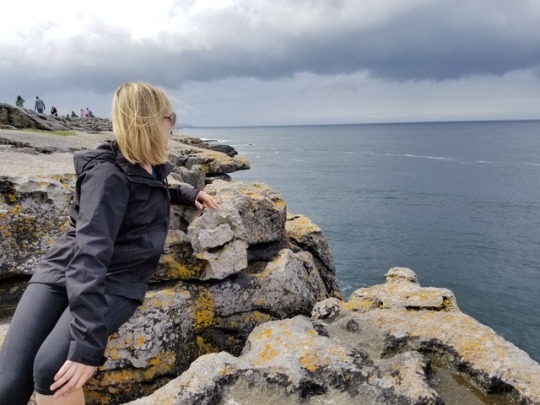
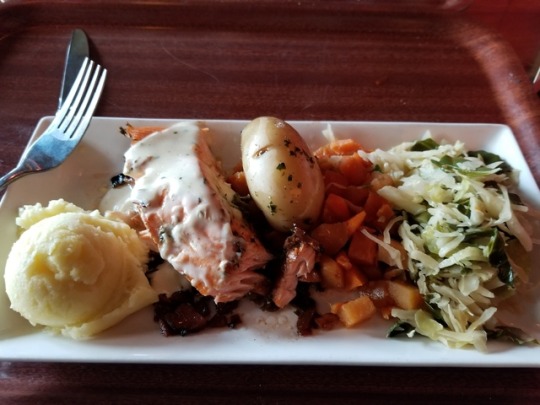
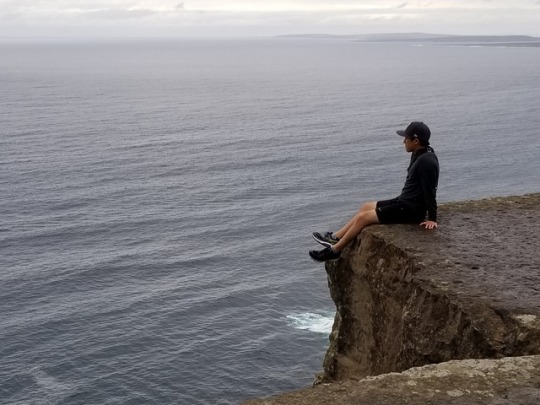



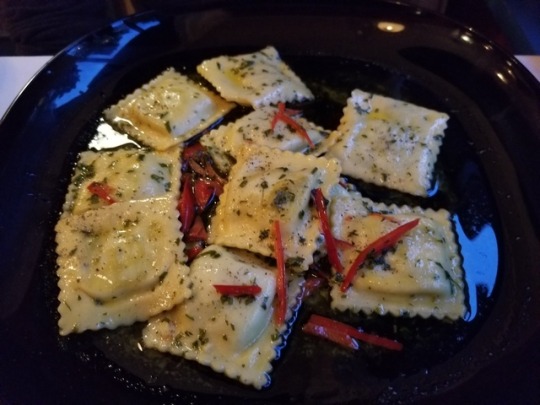
The tour bus left at 8 am on the dot. Our driver was Paul, a native of Galway but currently lives in Dublin. Let me tell you, this guy is an entertainer. Before introducing himself, he is singing the Molly Malone song on his headset. He is quite a jokester....poking fun of Trump, teaching us some Irish slang and giving us advice on drinking. Aside from his one of a kind entertainment, he is very informative in the history of Dubin and Ireland in general. He points out key landmarks and provides facts as we pass the point of interest.
Our first destination was Kinvara, south of Galway. It is a small town that makes a good stop for a bathroom break or if you want to grab tea/coffee. There is a nice farmer's market every Friday. We got a nice slice of a vegan vegetable quiche and a box of various hummus. I like trying homemade food, especially outside a traditional restaurant setting. It is a chance to be in their shoes and eat what the locals eat.
We then went to the baby cliffs, a sneak peek of the Cliffs of Moher. There is nothing baby about these cliffs. We got some great pictures including one with my feet off the rocks, looking down at the waves. We also climbed to a high point where you can see the beautiful ocean.
Lunch at Fitzpatrick's in Doolin, Ireland wasn't bad. I have come to realize that some of the food in Ireland, especially the vegetables are seasoned minimally or not at all. Which is fine because everywhere you go, you have to respect the culture and how they do things there. The salmon we had was cooked perfectly. You can't get any fresher than salmon from the Atlantic ocean. We learned the fisherman are only allowed 10 catches of salmon a year to perserve the species. Unlike the potatoes, carrots and cabbage I had with the fish, the vegetable soup was full of flavor and seasoning. Very delicious.
We were on the great Wild Atlantic Way for some time. It is one of the longest driving routes in the world. Like many of the bodies of water we have come across on our European trip, the ocean was amazingly blue. We saw many farm animals roaming the fields. We also saw the stone walls that divide houses, yards and meadows. Many of the stone walls have been here for hundreds and even thousands of years. During the potato famine in the 19th century, the country lost about 2 million people; either to death or immigration to other countries. The king knocked down majority of the houses, as a sign to never come back to Ireland. But a lot of the stone walls survived and still divide the land nicely today.
We arrived to the Cliffs of Moher around 2 pm. We had exactly 1 hour and 30 minutes to explore on our own. The reason we have such a specific time limit is because it is for the safety of the tourists. Every year, on average a hundred people die exploring the cliffs. The government currently restricts all tour companies 1.5 hours time for their groups; in efforts to minimize the number of deaths. Whether it actually has an effect, we are unsure stated the bus driver.
Although it was raining, we still had breathtaking views of the cliffs and water. Paul has stated a dozen times this year, groups would come to see the rocks and there would be dense fog covering everything in sight. The rain was actually on and off. There has been such a heat wave in all the cities and countries we have visited. It is amazing to say that Friday was my first rainy day of the 33 days I have been traveling in Europe. It was Jackie's second; her first rain was day 11 in Monaco and it only lasted 2 hours. After several weeks of suffering in the heat, we welcomed the rain.
Our last stop of the day was Bunratty, between Shannon and Limerick, Ireland. We had just enough time to take a picture of the famous Durty Nelly's Pub and the Bunratty castle; check out the gift shop; and use the bathrooms. Paul strongly suggested not to drink any alcohol or liquids, as we had a straight 2.5 hour drive back to Dublin. We thought the tour was great; even though we had limited time at each point of interest, we got a good idea of what it was like outside of Dublin. And sometime in the future, we can return to the towns we enjoyed the most. Paul made the trip entertaining and fun. Some of those scenic routes we took were just unbelievable.
For dinner, we ate at a small Italian restaurant called I Mornelli. The service was slow but was made up in the delicious pasta dishes. We realized how much we missed Italy....and how much we will miss being away on our honeymoon...away from our work, daily tasks and stress. We still have one more day in Dublin. We hope to check out Merrion Square, the Oscar Wilde statue and the Epic Museum...where Jackie can learn more about her family history.
0 notes
Text
Friday Five with Paul McClean
Photo: John Russo
Contemporary architect Paul McClean, founder of McClean Design, grew up in Ireland, where he later attended the Dublin Institute of Technology. After graduating with honors, he relocated to Southern California and worked for various architectural firms before establishing McClean Design in 2000. Thanks to the creation of lasting relationships with leading builders and designers, he’s helped ensure that his entire team is committed to realizing the dreams and aspirations of their clients. McClean is a member of the American Institute of Architects and works primarily in California, Hawaii, and Nevada. He recently released his first book, McClean Design: Creating the Contemporary House, that takes us behind the scenes of 21 of the architect’s homes that have been completed in the past fifteen years. Today, Paul McClean is joining us for Friday Five.
I have always enjoyed working with different people and am constantly amazed by the different and varied backgrounds of our clients. Design is more than a job for me. It is what I wanted to do as a little boy and which I am lucky enough to be able to practice today and hopefully for a very long time.
-Paul McClean
Photo: Jim Bartsch
1. Light Our projects always start with light, architecture is just a way of sculpting light in the end. I think we sometimes forget how important light is to our moods and well-being. Growing up in Northern Europe the winters were long and dark, and I think that’s part of what attracted me to coming here in the first place. Upon leaving a greyhound bus terminal in San Francisco many years ago, my initial impression of California was an intense blue sky laced with watery fog. We spend a lot of time thinking about how light will work in a space, trying to find ways to ensure that we have different exposures so that you can feel the movement of sun as the day passes.
Photo: Simon Berlyn
2. Water Water is life, but here in Southern California the landscape is mostly defined by the lack of it. Coming from a wet climate, I gravitate to water as a design tool. We borrow from the long history of using water in arid climates as a source of cooling and comfort. All of our projects incorporate water as a defining element; we use pools to passively cool spaces, to control how people move, to reflect light deep into spaces, and to act as a mirror to the landscape and sky. We generally choose dark finishes to enhance the reflectivity of the water.
Photo: Simon Berlyn
3. Nature We are really fortunate in Southern California to live in a very mild climate. Here, if you add water, almost anything will grow, but I find that every landscape is beautiful. I can only say that for me the desert landscape is as inspiring as a tropical mountain. In our work, we try to make sure that landscape and nature are a fundamental part of the design; we work to break down the barriers between interior and exterior space so that you remain connected to your surroundings rather than separate from them.
Photo: Jim Bartsch
4. View Any project we do starts with how we can enhance the views that surround us. We have been really lucky to work on amazing sites with views of the city, canyons, or the sea, but even a dense urban site has a view of the sky. The trick is to edit the view so that we can find balance and a little serenity for the people within. We will often edit views like a director, establishing the scene. We do this by strategically placing buildings, landscape components, and water to control how you walk the property and see the surroundings; for example using a tree to block an unsightly utility pole or a pool to prevent you from walking to the end of the yard to see the street below. It can also be as simple as a sculpture at the end of a garden to draw the eye.
Photo: Jim Bartsch
5. Architecture It would be hard to imagine a life without architecture for me. I wanted to be an architect since I was a small boy, and I have trouble visualizing what I would do if I couldn’t practice it. It’s more of a calling than a job and an integral part of who I am, there really was no other option. I am continually inspired by the great work I see being done by so many professionals out there, most of it unsung – including our friends working in interior and landscape design. I am frequently humbled when I see the quality of projects that have been done in the past; visit any city in Europe, for example, and just walk around and look at all the beautiful design work done over the centuries. Not to mention the astonishing work of the distant past, such as the Pantheon in Rome or the Parthenon in Athens. It’s often the smaller buildings that surprise me though; we visited Bruges in Belgium this year and every street was full of wonders, and I don’t mean the chocolate.
Work by Paul McClean:
Casale \\\ Photo: Jim Bartsch
Robin \\\ Photo: Simon Berlyn
Skylark \\\ Photo by Simon Berlyn
via http://design-milk.com/
from WordPress https://connorrenwickblog.wordpress.com/2020/07/24/friday-five-with-paul-mcclean/
0 notes
Text
Back Home, Now What?
It’s stupidly hard for me to comprehend that a month ago, I was wandering the streets of Lisbon, and today I’m sitting at the kitchen counter with my parents. It’s especially been weird to see posts from my friends still in Europe or the national friends I made abroad. The people I was seeing daily for over four months, who now only exist on my cell phone screen.
The above paragraph is in italics because it was the original introduction I wrote to this post back in January. I meant to post it then, but life got in the way and then college got back in the way. I’ve been back to campus now for longer than I was home for break. So, bear with me as I take you on a journey through a post that spans the course of nearly two months and includes some of the most growth I’ve ever had in my life. Beginning with day one of life in the United States…
Mainly, the suckiest thing I’ve discovered about going abroad in the fall is the timing of your arrival home.
Most institutions of higher education in the States end their fall semester in early to mid-December and don’t return to campus until almost the end of January. Winter break is roughly 4-6 weeks long, depending on where you go and when your finals end. Generally, this break is needed. No matter how much you love college, it’s always nice to get a breather from cafeteria dinners, early classes, and the loud students in your dormitory. I suppose I should say, however: it’s nice for two weeks and then you cannot wait to get the hell out of your house.
My abroad program didn’t end officially until the day I flew home, December 21st. That meant, of course, I was getting home the week of Christmas.
Fortunately, I wasn’t nearly as jetlagged coming back home as I was when I arrived in Amsterdam. Between sleep deprivation and jetlag, it took a good week for me to adjust to my surroundings and my sleep schedule. On top of that, I admittedly spent a huge portion of my time in the first week partying harder than I really ever had before and was home just before dawn for four nights in a row. The air felt different, the food was new, and I had never walked into a restaurant and been spoken to in Dutch before. It was a lot of adjusting to make in a week, and when I was at my house, I was napping or watching something American on Netflix to remind myself just what the hell I was doing.
Coming home was thankfully far less exhausting, but it had its moments. My flight home was a connection flight; I flew out of Amsterdam at roughly nine in the morning Dutch time, endured a three-hour connection in Ireland, and flew out of Dublin in the early afternoon.
I left Amsterdam at six in the morning and didn’t go to bed in the States until it was nearly 5 am my personal time. The next day.
Almost instantaneously, I was thrust into a week of family-oriented activities. On some level, this was a bit of a blessing. Time planned (not by even by me personally) to see everyone who would want to see me in one week. Unfortunately, I might say, it did mean that I was on autopilot, completely unaware of what day it was or having an idea of how I was supposed to return to my “old life”. I know four months seems like it’s barely a thing, but a huge amount of stuff happened in those four months. I had had just enough time to build a new life in a new place with new people, which was very much needed. By the time I came home, I felt like I’d been living in Amsterdam for my entire life. It was hard to come back to my old one, where everything had been moving forward without me.
Admittedly, I am not a fan of going home, and I haven’t been since I started college. It’s not quite that I don’t like my hometown; I love my house, the area I grew up in, and my close friends. I have, however, grown a lot since I lived in my town full time. Returning home feels like running into that kid—high school Quinn. I don’t like that kid.
This winter break felt different. For starters, I was only home about three weeks. One of which was the craze of the holiday season. Truthfully, I only felt like I had two weeks to hang out and do nothing.
I don’t have many close friends from my area anymore, about three to four. My general friend group is much bigger than that but consists of mostly peers further on the east coast, European friends, and internship friends scattered around the country. Being home is a nice period of relaxing and not feeling like I have to being going out daily to be living my college experience to the fullest. This break almost didn’t feel like enough time to hermit.
Perhaps the biggest reason the break felt strange was because, in my heart, I knew it was the last time I’d spend time with my dog.
My parents had told me about my dog’s cancer diagnosis when I was a little under my halfway point of abroad. I spent a lot of the remaining time in Amsterdam lying awake in anxiety that I wouldn’t see my dog again. I didn’t feel like I had sufficiently said goodbye to her. I didn’t like that I had potentially taken her on a final hike without knowing it.
Thus, my winter break was buoyed by squeezing time with friends in, hiking as often with my dog as I could, and prepping my resume for another semester of applying to internships.
I didn’t feel much culture shock in the time I was home. But when I returned to campus, reverse culture shock hit me harder than the puberty train. For those who know me now but did not know me when I was ten, the puberty train smacked me hard.
I had to be back at school for residence life training, so I was back on campus before a lot of my friends. As my parents moved me back, made my bed, and took me to Walmart, I had the feeling in the pit of my stomach that that drop-off would be the last time I would see my dog.
The three days of training were exhausting. I came back to my room every night post-dinner and stared at my blank ceiling for an hour just to regain consciousness. I wish I was being overly dramatic.
Less than a full week after my parents moved me in, they called me late one night after I had gotten back from the gym to tell me they had put our dog down that day. I momentarily became emotional over the phone, but then stopped myself. We chatted for another few minutes, and then the moment I hung up the phone, I sobbed.
The rest of the week became an ultimate blur of new classes, what felt like a new campus, and the occasionally waterworks over the loss of my fluffy best friend.
Later that same week, I attended an MLK teach-in regarding tips and advice on student activism. The lecture was awesome and given by one of my favorite professors in my department. Something, though, was off about it.
By nature, I am a very introverted human. If you take me to a dance, sporting event, family gathering, or virtually any event where I have to be social and chatty for longer than a few hours, you’ll notice how tired I become. When I am overly exhausted from socializing, I call it being in “overdrive”; I get restless, sometimes slur my words, or simply shut down. It’s a little like being drunk, but not in the good way. When I was really little, I would noticeably, yet often subconsciously, flap my arms in public if I was too exhausted from socializing.
This all said, I have never been a socially anxious person. I’ve been all forms of anxious, but never socially.
Return to this lecture. They held their teach-in schedule in Stretansky Hall, the auditorium in the music building where music majors roam. I walked there from the library, after a solid 2-3 hours of sitting in a study room alone. I ventured outside, walked over to Cunningham, and entered the building.
Almost as soon as I was inside, where I saw people I knew and received greetings, I felt like I was beginning to panic. I nearly ran through the hallways to get to the auditorium, where I had to stand outside with a small crowd before the doors opened. When we walked in, I found a middle seat and sat alone. I have no issue with sitting alone. In fact, sometimes I prefer it over sitting next to another person who will talk to me.
I sat in my seat, silently panicking.
I have a few other “ticks” I do when I’m socially beat: grind my teeth, tap my foot, pick at my cuticles, bit my lower lip, sometimes slightly rock back and forth. I was sitting in this chair, in an auditorium that wasn’t even full, doing almost every tick at once.
Perhaps the weirdest part, was that I didn’t really know why I was that nervous. My heart wasn’t racing, I wasn’t telling myself to be nervous. I just was.
It made me nervous to be nervous. I’ve only had, of my own recollection, one panic attack in my entire life. It was sometime, I think, in early high school, when nobody my age had their driver’s license. We were on the bus in the afternoon when our area was issued a tornado warning. As a preteen, I had a life-altering problem with storm anxiety.
I remember sitting on the bus, maybe five minutes from my house, hyperventilating. I didn’t get particularly showy about how much I was panicking, but I knew I was having a panic attack.
I didn’t have an actual panic attack sitting in the audience of this lecture, but I knew if I didn’t relax, one was probably coming.
After a few minutes, I did calm down. The presentation started, the room went quiet, and I chilled out.
A few hours later, I texted a few of my close friends about this. I hadn’t had any other serious anxiety issues that week, but I had had difficulty entering the café when it was busy or being comfortable with sitting by myself in a crowded room.
The friends I told are all very good friends of mine; two attend my school but are abroad this semester, three live far away at other universities, and one lives in Europe. For the most part, none of them know one another. They know of each other’s existence in my life, but they’ve never met. Their commonality is that they all love me dearly.
I told them about this incident, how it almost felt like an out-of-body experience. They all, independently of one another, agreed that social anxiety was unlike me. They know I am introverted, but they all agree it’s really not like me to feel anxious in crowds. I like lectures, concerts, cities, public transportation, and running at the gym. To walk into a place where there’s other people and be nervous for that reason alone, is nothing like me.
The following weekend, one of these humans, amongst my favorite of all time, came up to visit me. We got food, went ice skating, got drunk, and laughed really hard. After she left, later that day, we joked about our moms asking about our friends. She asked if I was still feeling anxious and if I was going to the counseling center. I told her maybe, and she Venmoed me $20 so I could go buy a stress-relieving candle.
Another of my friends, who lives far away and whom I haven’t seen for several months, asked if I was going to therapy that week. When I gave him the same “maybe”, he reminded me that the previous week, I said I would. I told him I’d go Thursday if I wasn’t feeling any better, and he said he was not only holding me to it but would drive to my school and take me there himself if I refused. My friends from abroad sent me hearts over text and told me I could call them if I needed some help.
One, this pretty much proved to me that after two decades of struggling to find them, I’ve finally got the good friends I’ve always wanted. Second, part of me naively assumed when I returned from being abroad, I wouldn’t have any issues doing so.
I’m described, both by others and by me, as a very chill human being. It takes a lot to stress me out, and even more to make myself tell people how I feel. Feeling an emotion so closely that I had to tell people about it in order to make the guilt go away was rare. Really rare, and really undesirable.
Attention-seeking and gaining sympathy is not why I want to write a post that connects so deeply to my inner core. I write this post because reverse culture shock and readjustment are things that happen to most college students, and we need to do more for said students than just throw them back on campus and put syllabi in front of them.
At the beginning of week 5 of this semester, I feel a lot more like my old self. I’ve reached out to my friends, left my room for several hours at a time, and gotten back to my usual college routine.
I talked and thought about this a lot when I was physically abroad, but I find it even more concerning now that I’m home. Studying abroad is hard. Really, really hard.
My university’s study abroad requirement is amazing. It’s incredible to attend such a small university in the middle of Pennsylvania and produce hundreds of graduates a year who had some sort of eye-opening abroad experience at some point in their education. I was against studying abroad in high school but doing it in college made me seriously regret my prior decision.
A lot of the post-abroad process you endure when you return to campus deals with marketing yourself. You learned valuable skills in between side trips and partying three times a week, right? Why don’t you come up with a way to turn that into something employable on your resume?
There’s nothing wrong with a program that focuses on that particular part of post-abroad. The job market is more global now than it was when I was a toddler or even in high school. Nothing is wrong with letting an employer know that you have the skillset to deal with foreign affairs or communicate cross-culturally.
What I do critique about the program, and a lot of other students do, is the overlooking of students who return to campus and just don’t feel right. If I don’t feel like myself or I don’t like returning to my old life, I won’t want to market that to anybody. Including myself.
My transition back to school was pretty quick but also pretty painful. Taking everything I’ve learned about myself in a different country and bringing it back to campus with me was a heavier load than I imagined.
Normalizing your lifestyle again and convincing yourself that you’re okay is one thing. Accepting your struggle and refusing to let it slow you down is another. Sometimes, I feel like I have rocks tied to my shoes. But, if you walk far enough, eventually those rocks erode down to pebbles, and you get to start running.
0 notes
Text
Things You Should Know Before Renting A Car & Driving In Ireland
Tips For Renting A Car In Ireland
Ireland Driving Guide
Renting a car in Ireland and driving around the country yourself is a wonderful way to experience the Emerald Isle. But here’s some advice about the best way to do it.
When my family and I were planning our genealogy trip to Ireland to learn more about our ancestors, we were initially hesitant about renting a car to explore the country by ourselves.
Ireland has a bit of a reputation for narrow and scary winding roads!
Plus of course, they drive on the other side of the road, so there’s that. But the more we researched, the more we realized renting a car in Ireland would allow us to make our itinerary as imaginative as possible.
I love the freedom of road trips and planning my own travel itineraries. Ireland is such a diverse country that it made sense to rent a car so we could stop anywhere to discover small villages, castles, and ancient ruins at our own pace.
Here are some important tips we learned from our experience renting a car in Ireland, to help you save money and stay safe while driving around the country!
How To Rent A Car In Ireland
Driving in Ireland for Tourists
Should You Rent A Car In Ireland?
Hey, if you love those big group bus tours, by all means, go book one. It’s a decent way to see Ireland if you don’t have a lot of time.
No planning, no driving, just sit back and let someone else do all the work!
But if you’re like me, you prefer the adventure of independent travel.
No set schedule or timetable — driving around Ireland with the freedom to stop anyplace cool you find along the way.
If that’s the kind of traveler you are, renting a car in Ireland is the way to go!
Just keep in mind that some of the backroads in Ireland can be very narrow, and often feel like a single lane (but they’re not). With some practice, you’ll gain confidence on them!
Another nice thing we enjoyed about having a car was the ability to store things in the trunk, stopping off in Irish towns with small daypacks rather than hauling luggage everywhere.
Learning to Drive on the Opposite Side!
Where To Rent Your Car In Ireland
The best site to book your car is Discover Car Hire. They search both local and international car rental companies to help you find the best possible price. This is the easiest way to rent a car in Ireland.
We rented our car from Dublin Airport after spending a few days in the city. Our South West route brought us to Cork on the M8 before moving on to Killarney National Park and then Glengarriff, where my grandmother was born.
After tracking down our family history in this small coastal fishing village, we drove North on the Wild Atlantic Way up to Dingle and the famous Cliffs of Moher, then to Galway, and finally back to Dublin.
However there are many different road trip routes you can choose when driving in Ireland. Other major airports to consider picking up a car are Shannon in the Southwest and Cork in the Southeast.
Crazy Irish Winding Roads!
The Amazing Cliffs of Moher
Car Rental Insurance In Ireland
Some of the rumors about driving in Ireland are true, and the roads are VERY narrow in areas. Especially the backroads outside Ireland’s smaller towns. Don’t worry, I’ll share some tips for dealing with them below.
This is why I highly recommend getting full insurance coverage.
Typically, rental cars in Ireland come with a basic Collision Damage Waiver (CDW), but this isn’t exactly insurance, and only covers the car for up to €1000-3000 EUROS worth of damage.
This is the amount they hold on your credit card until you return the car in one piece. CDW typically does not include tire, cracked windshield, or undercarriage damage either.
While you can often save money booking your car with a credit card that includes car rental insurance, you REALLY must read the fine print, because many people wrongly assume their card covers them in Ireland.
If you get in a wreck driving in Ireland, declined full coverage, and you suddenly learn your credit card doesn’t actually cover the damage — you’re screwed. I can’t tell you how many travel horror stories I’ve heard like this…
It’s why I usually pre-book full coverage online. It’s cheaper than at the counter — and then you won’t have to worry about accidents at all!
The Stunning Cobh Cathedral
How Much Does It Cost To Rent A Car In Ireland?
Renting a car in Ireland is going to cost you around $25-$40 USD a day, depending on the type of car you get. Our 4 door sedan was about $30 per day.
I recommend renting a car with an actual trunk (no hatchbacks) to hide your luggage from prying eyes. It helps to prevent break-ins if thieves can’t see your stuff.
Gas Prices
Gas (petrol) prices in Ireland might seem cheap to Americans, but remember that the rest of the world quotes gas in Liters, not Gallons (1 Gallon = 3.78 Liters). Currently, gas costs about $5.90 per gallon (€1.40 per liter) in Ireland. Diesel cars will often save you some money on gas.
Automatic vs Manual
Automatic cars are more expensive to rent than manual cars (but manuals are more common in Ireland), and you must specify what type you want when booking.
One-Way Rentals
There’s also an additional fee for one-way car rentals, which can vary by company. For example, if you want to drop off the car in a different city than you started from.
Admin Fee
If you opt to use your own credit card insurance, companies will charge you an “admin fee” of about €30 EURO.
Credit Card Fee
I was charged an extra €5 EURO just for using a credit card. Which is strange to me, but typical in Ireland.
Irish Taxes
Car rentals in Ireland have a very high tax rate of 13.6%. Ouch!
Age Requirements For Renting A Car
The minimum age for driving in Ireland is 18 years old, however most car rental companies enforce their own age limit of 21 years old to rent a car. They also charge an additional fee if you’re under 24 years old.
Driving Through the Town of Killarney
Irish Driving Laws Tourists Should Know
The most confusing part of driving in Ireland for most tourists is driving on the left side of the road — with the driver’s seat on the right side of the car.
If you’ve never been to a country that drives on the left, it’s wise to practice a bit in a small town before you head onto the highways of Ireland.
For example, just North of Dublin Airport is the town of Swords. Maybe spend an hour or two getting the hang of driving there before you enter Dublin or onto the main highways.
While challenging at first, especially if driving a manual, you’ll get the hang of it quickly and will be ready to explore Ireland by car in no time!
The speed limit on local roads is generally around 80 km/h while on national highways it’s up to 100 km/h.
International Driver’s License
No, you do not need an international driver’s license to drive in Ireland or rent a car there. Just bring your passport, credit card, and your driver’s license from your home country.
Ross Castle at Sunrise
Helpful Tips For Driving In Ireland
Watch out for sheep! In many smaller towns, local shepherds move their sheep on the roads. You can easily round a sharp bend and find yourself stuck behind a huge flock walking down the road.
Narrow backroads in Ireland don’t have standard break-down lanes as we have in America. There’s often no room for error or pulling over.
Sometimes your side-view mirror will be inches away from stone walls or hedges while passing other cars! It can make driving here nerve-wracking.
Remember to carry some cash for road tolls on Ireland’s major highways. Irish tolls can cost between $1-$3 for a passenger car.
In the countryside, some roads are truly single lane, but with traffic in both directions. In these situations, there are pull-outs so one of you can pull over for the other to pass.
USEFUL TIP: Buy a cheap “learner” sticker (L) sold at gas stations so locals don’t get pissed off at your incompetence on their roads!
The Colorful Town of Glengarriff, Ireland
Advice For Renting A Car In Ireland
You don’t need a rental car for Dublin itself. Parking can be a pain and Dublin is very walkable with excellent public transportation too.
If you’re starting your trip in Dublin, maybe book a rental car when you’re ready to leave the city, for exploring the rest of the country.
Don’t book a car without reading the company reviews. You’ll find plenty of bad reviews for every company (people love to complain online), but try to pick one with the LEAST bad reviews.
You may not always get the make/model/type of car you booked. If they give you a smaller car, or a manual when you asked for an automatic, be pushy and ask for an upgrade.
Inspect your car thoroughly and record video on your smartphone pointing out damage before you leave. This is a backup if they attempt to charge you for damage that was already there.
Pay attention to if your car takes regular petrol or diesel fuel, so you fill up with the correct type at gas stations.
Use Google Maps on your smartphone for directions. Bring your own hands-free adapter and buy an Irish SIM card at the airport.
Enjoy Your Ireland Road Trip!
Exploring the small villages, ancient castles, green mountains, and coastal cliffs of Ireland in a rental car was definitely the right choice for us.
Self-drive road trips get off the beaten track to see things most people miss! ★
➜ Check Car Rental Prices & Availability In Ireland
Travel Planning Resources For Ireland
Packing Guide
Check out my travel gear guide to help you start packing for your trip. Pick up a travel backpack, camera gear, and other useful travel accessories.
Book Your Flight
Find cheap flights on Skyscanner. This is my favorite search engine to find deals on airlines. Also make sure to read how I find the cheapest flights.
Rent A Car
Discover Car Hire is a great site for comparing car prices to find a deal.
Book Accommodation
Booking.com is my favorite hotel search engine. Or rent apartments from locals on Airbnb. Read more about how I book cheap hotels online.
Protect Your Trip
Don’t forget travel insurance! I’m a big fan of World Nomads for short-term trips. Protect yourself from possible injury & theft abroad. Read more about why you should always carry travel insurance.
Enjoy This Post? Pin It!
READ MORE FROM IRELAND
How To Visit The Cliffs Of Moher The Best Of Dublin Travel Guide My Irish Genealogy Road Trip Claiming Irish Citizenship By Decent
Any questions about driving or renting a car in Ireland? Are you planning a road trip there? Drop me a message in the comments below!
This is a post from The Expert Vagabond adventure blog.
from Tips For Traveling https://expertvagabond.com/renting-car-in-ireland/
0 notes
Text
Things You Should Know Before Renting A Car & Driving In Ireland
Tips For Renting A Car In Ireland
Ireland Driving Guide
Renting a car in Ireland and driving around the country yourself is a wonderful way to experience the Emerald Isle. But here’s some advice about the best way to do it.
When my family and I were planning our genealogy trip to Ireland to learn more about our ancestors, we were initially hesitant about renting a car to explore the country by ourselves.
Ireland has a bit of a reputation for narrow and scary winding roads!
Plus of course, they drive on the other side of the road, so there’s that. But the more we researched, the more we realized renting a car in Ireland would allow us to make our itinerary as imaginative as possible.
I love the freedom of road trips and planning my own travel itineraries. Ireland is such a diverse country that it made sense to rent a car so we could stop anywhere to discover small villages, castles, and ancient ruins at our own pace.
Here are some important tips we learned from our experience renting a car in Ireland, to help you save money and stay safe while driving around the country!
How To Rent A Car In Ireland
Driving in Ireland for Tourists
Should You Rent A Car In Ireland?
Hey, if you love those big group bus tours, by all means, go book one. It’s a decent way to see Ireland if you don’t have a lot of time.
No planning, no driving, just sit back and let someone else do all the work!
But if you’re like me, you prefer the adventure of independent travel.
No set schedule or timetable — driving around Ireland with the freedom to stop anyplace cool you find along the way.
If that’s the kind of traveler you are, renting a car in Ireland is the way to go!
Just keep in mind that some of the backroads in Ireland can be very narrow, and often feel like a single lane (but they’re not). With some practice, you’ll gain confidence on them!
Another nice thing we enjoyed about having a car was the ability to store things in the trunk, stopping off in Irish towns with small daypacks rather than hauling luggage everywhere.
Learning to Drive on the Opposite Side!
Where To Rent Your Car In Ireland
The best site to book your car is Discover Car Hire. They search both local and international car rental companies to help you find the best possible price. This is the easiest way to rent a car in Ireland.
We rented our car from Dublin Airport after spending a few days in the city. Our South West route brought us to Cork on the M8 before moving on to Killarney National Park and then Glengarriff, where my grandmother was born.
After tracking down our family history in this small coastal fishing village, we drove North on the Wild Atlantic Way up to Dingle and the famous Cliffs of Moher, then to Galway, and finally back to Dublin.
However there are many different road trip routes you can choose when driving in Ireland. Other major airports to consider picking up a car are Shannon in the Southwest and Cork in the Southeast.
Crazy Irish Winding Roads!
The Amazing Cliffs of Moher
Car Rental Insurance In Ireland
Some of the rumors about driving in Ireland are true, and the roads are VERY narrow in areas. Especially the backroads outside Ireland’s smaller towns. Don’t worry, I’ll share some tips for dealing with them below.
This is why I highly recommend getting full insurance coverage.
Typically, rental cars in Ireland come with a basic Collision Damage Waiver (CDW), but this isn’t exactly insurance, and only covers the car for up to €1000-3000 EUROS worth of damage.
This is the amount they hold on your credit card until you return the car in one piece. CDW typically does not include tire, cracked windshield, or undercarriage damage either.
While you can often save money booking your car with a credit card that includes car rental insurance, you REALLY must read the fine print, because many people wrongly assume their card covers them in Ireland.
If you get in a wreck driving in Ireland, declined full coverage, and you suddenly learn your credit card doesn’t actually cover the damage — you’re screwed. I can’t tell you how many travel horror stories I’ve heard like this…
It’s why I usually pre-book full coverage online. It’s cheaper than at the counter — and then you won’t have to worry about accidents at all!
The Stunning Cobh Cathedral
How Much Does It Cost To Rent A Car In Ireland?
Renting a car in Ireland is going to cost you around $25-$40 USD a day, depending on the type of car you get. Our 4 door sedan was about $30 per day.
I recommend renting a car with an actual trunk (no hatchbacks) to hide your luggage from prying eyes. It helps to prevent break-ins if thieves can’t see your stuff.
Gas Prices
Gas (petrol) prices in Ireland might seem cheap to Americans, but remember that the rest of the world quotes gas in Liters, not Gallons (1 Gallon = 3.78 Liters). Currently, gas costs about $5.90 per gallon (€1.40 per liter) in Ireland. Diesel cars will often save you some money on gas.
Automatic vs Manual
Automatic cars are more expensive to rent than manual cars (but manuals are more common in Ireland), and you must specify what type you want when booking.
One-Way Rentals
There’s also an additional fee for one-way car rentals, which can vary by company. For example, if you want to drop off the car in a different city than you started from.
Admin Fee
If you opt to use your own credit card insurance, companies will charge you an “admin fee” of about €30 EURO.
Credit Card Fee
I was charged an extra €5 EURO just for using a credit card. Which is strange to me, but typical in Ireland.
Irish Taxes
Car rentals in Ireland have a very high tax rate of 13.6%. Ouch!
Age Requirements For Renting A Car
The minimum age for driving in Ireland is 18 years old, however most car rental companies enforce their own age limit of 21 years old to rent a car. They also charge an additional fee if you’re under 24 years old.
Driving Through the Town of Killarney
Irish Driving Laws Tourists Should Know
The most confusing part of driving in Ireland for most tourists is driving on the left side of the road — with the driver’s seat on the right side of the car.
If you’ve never been to a country that drives on the left, it’s wise to practice a bit in a small town before you head onto the highways of Ireland.
For example, just North of Dublin Airport is the town of Swords. Maybe spend an hour or two getting the hang of driving there before you enter Dublin or onto the main highways.
While challenging at first, especially if driving a manual, you’ll get the hang of it quickly and will be ready to explore Ireland by car in no time!
The speed limit on local roads is generally around 80 km/h while on national highways it’s up to 100 km/h.
International Driver’s License
No, you do not need an international driver’s license to drive in Ireland or rent a car there. Just bring your passport, credit card, and your driver’s license from your home country.
Ross Castle at Sunrise
Helpful Tips For Driving In Ireland
Watch out for sheep! In many smaller towns, local shepherds move their sheep on the roads. You can easily round a sharp bend and find yourself stuck behind a huge flock walking down the road.
Narrow backroads in Ireland don’t have standard break-down lanes as we have in America. There’s often no room for error or pulling over.
Sometimes your side-view mirror will be inches away from stone walls or hedges while passing other cars! It can make driving here nerve-wracking.
Remember to carry some cash for road tolls on Ireland’s major highways. Irish tolls can cost between $1-$3 for a passenger car.
In the countryside, some roads are truly single lane, but with traffic in both directions. In these situations, there are pull-outs so one of you can pull over for the other to pass.
USEFUL TIP: Buy a cheap “learner” sticker (L) sold at gas stations so locals don’t get pissed off at your incompetence on their roads!
The Colorful Town of Glengarriff, Ireland
Advice For Renting A Car In Ireland
You don’t need a rental car for Dublin itself. Parking can be a pain and Dublin is very walkable with excellent public transportation too.
If you’re starting your trip in Dublin, maybe book a rental car when you’re ready to leave the city, for exploring the rest of the country.
Don’t book a car without reading the company reviews. You’ll find plenty of bad reviews for every company (people love to complain online), but try to pick one with the LEAST bad reviews.
You may not always get the make/model/type of car you booked. If they give you a smaller car, or a manual when you asked for an automatic, be pushy and ask for an upgrade.
Inspect your car thoroughly and record video on your smartphone pointing out damage before you leave. This is a backup if they attempt to charge you for damage that was already there.
Pay attention to if your car takes regular petrol or diesel fuel, so you fill up with the correct type at gas stations.
Use Google Maps on your smartphone for directions. Bring your own hands-free adapter and buy an Irish SIM card at the airport.
Enjoy Your Ireland Road Trip!
Exploring the small villages, ancient castles, green mountains, and coastal cliffs of Ireland in a rental car was definitely the right choice for us.
Self-drive road trips get off the beaten track to see things most people miss! ★
➜ Check Car Rental Prices & Availability In Ireland
Travel Planning Resources For Ireland
Packing Guide
Check out my travel gear guide to help you start packing for your trip. Pick up a travel backpack, camera gear, and other useful travel accessories.
Book Your Flight
Find cheap flights on Skyscanner. This is my favorite search engine to find deals on airlines. Also make sure to read how I find the cheapest flights.
Rent A Car
Discover Car Hire is a great site for comparing car prices to find a deal.
Book Accommodation
Booking.com is my favorite hotel search engine. Or rent apartments from locals on Airbnb. Read more about how I book cheap hotels online.
Protect Your Trip
Don’t forget travel insurance! I’m a big fan of World Nomads for short-term trips. Protect yourself from possible injury & theft abroad. Read more about why you should always carry travel insurance.
Enjoy This Post? Pin It!
READ MORE FROM IRELAND
How To Visit The Cliffs Of Moher The Best Of Dublin Travel Guide My Irish Genealogy Road Trip Claiming Irish Citizenship By Decent
Any questions about driving or renting a car in Ireland? Are you planning a road trip there? Drop me a message in the comments below!
This is a post from The Expert Vagabond adventure blog.
from Tips For Traveling https://expertvagabond.com/renting-car-in-ireland/
0 notes